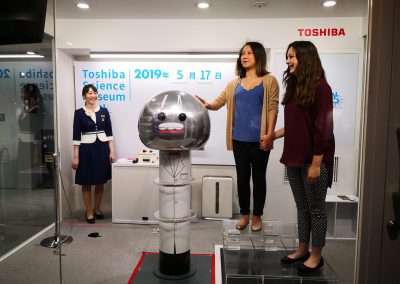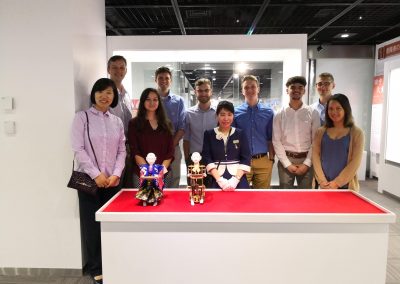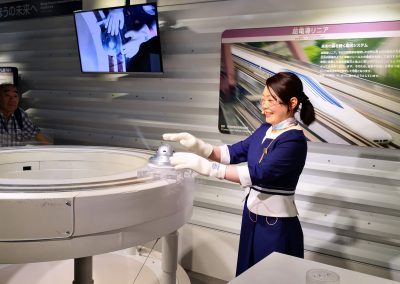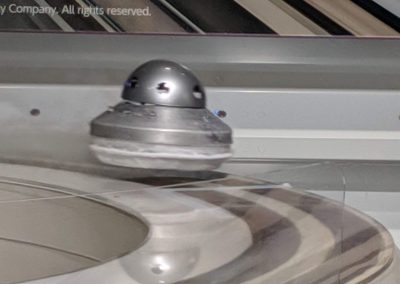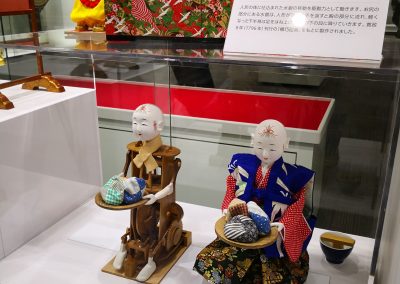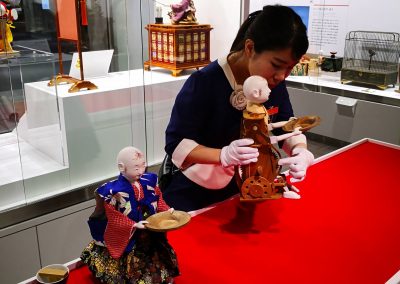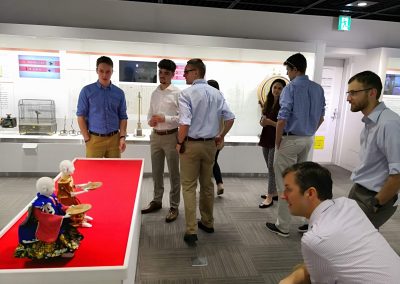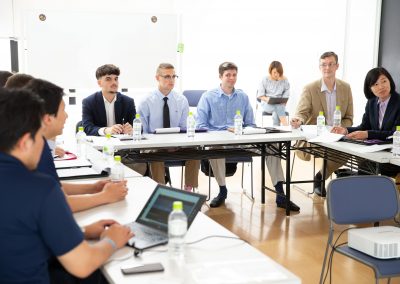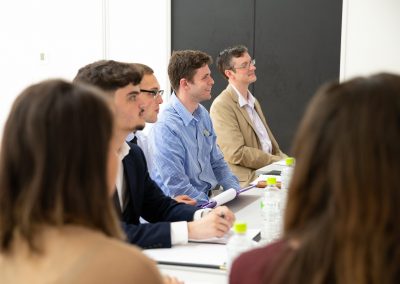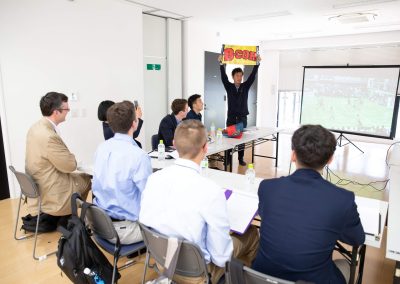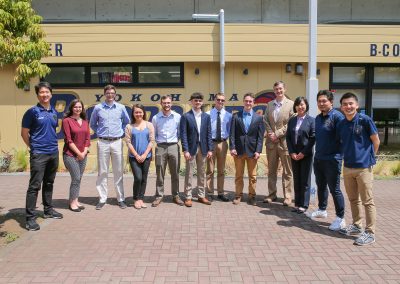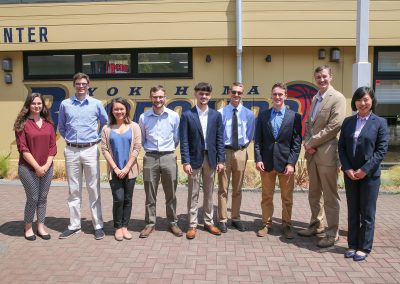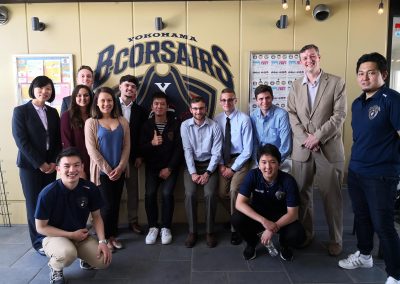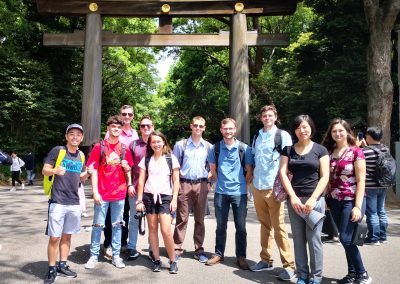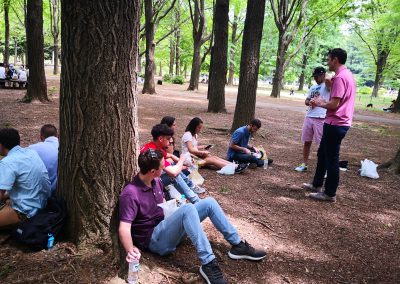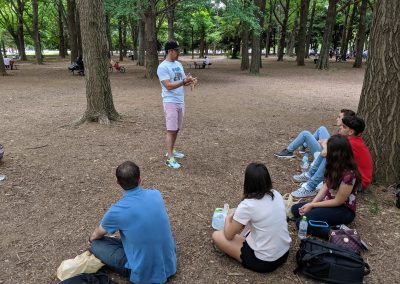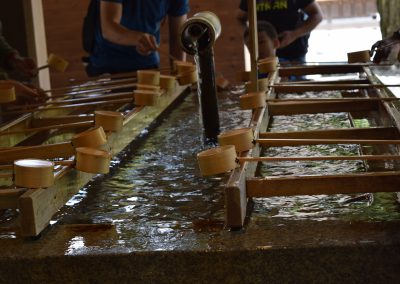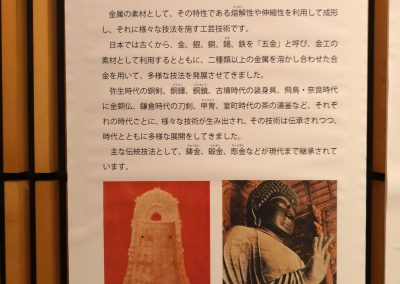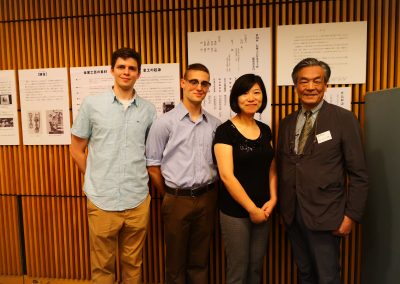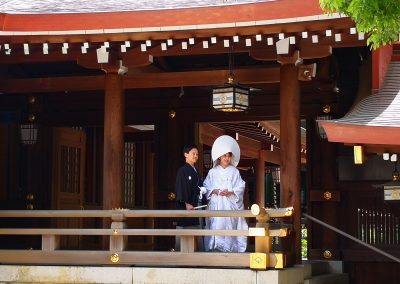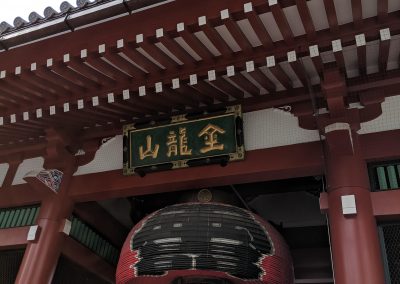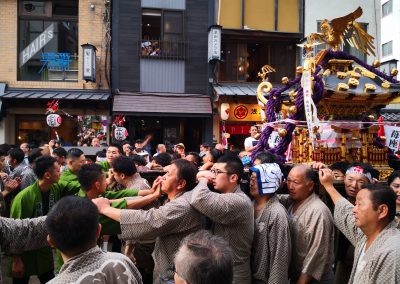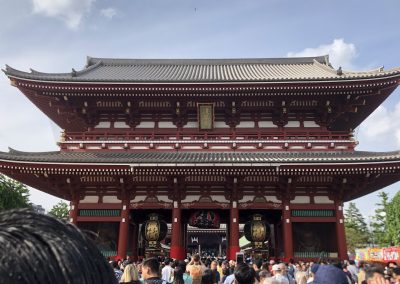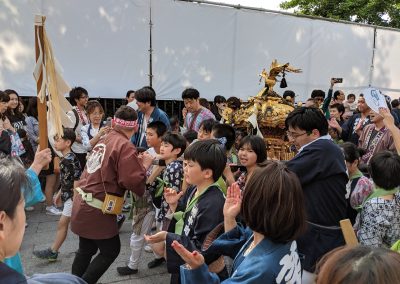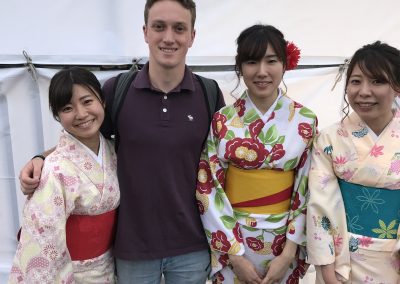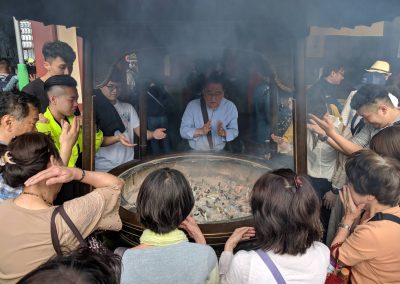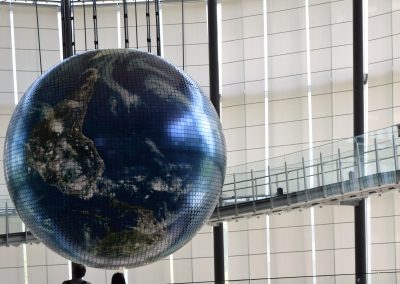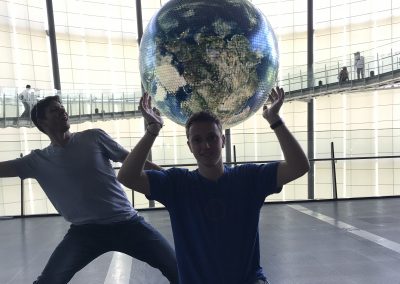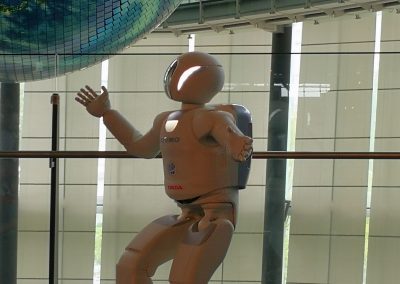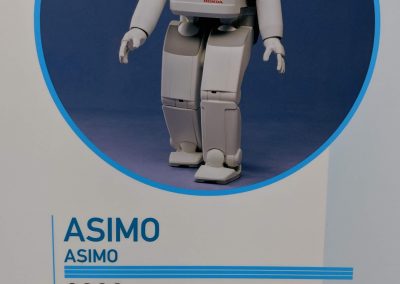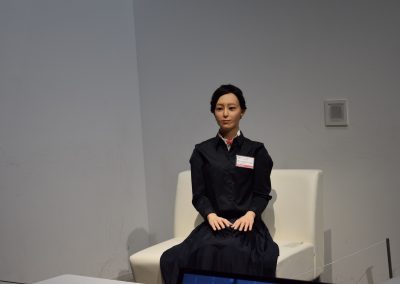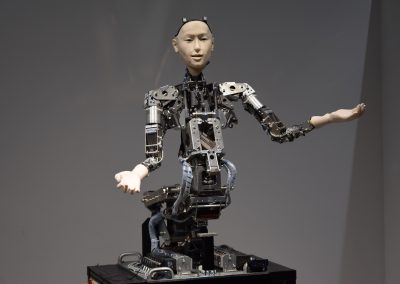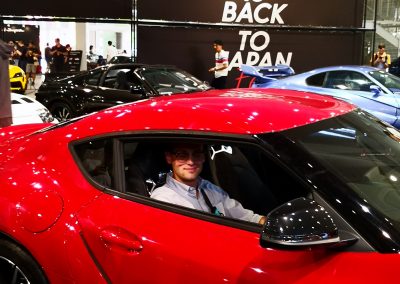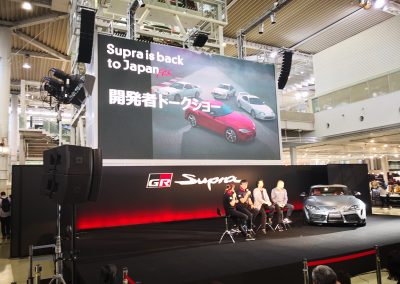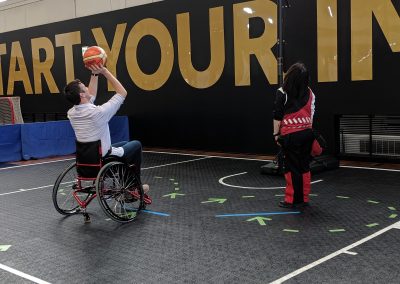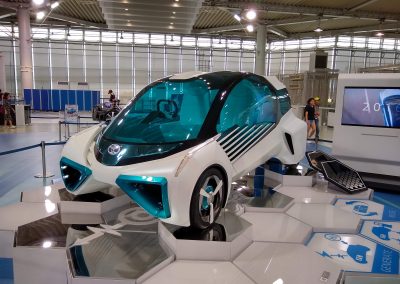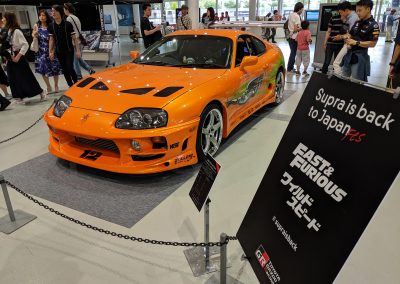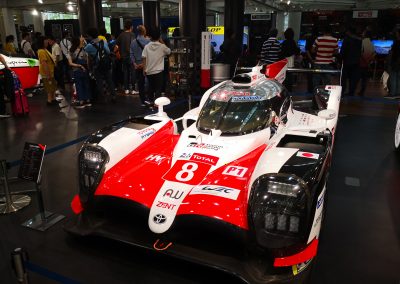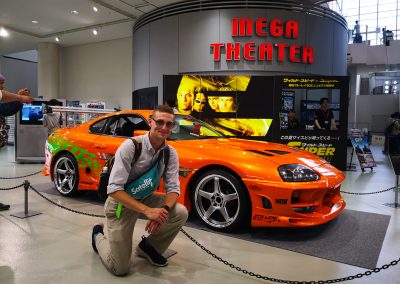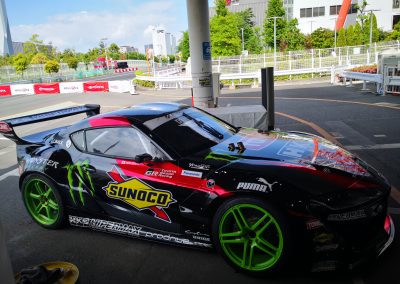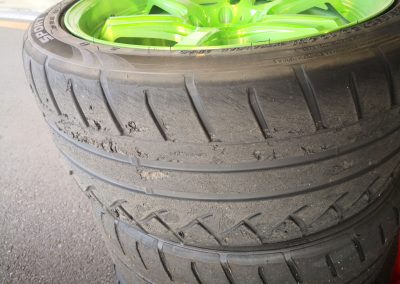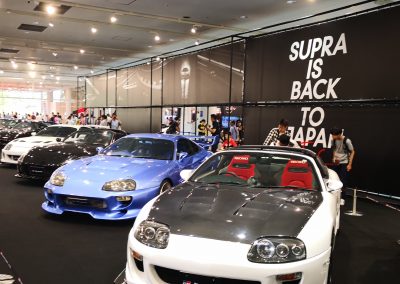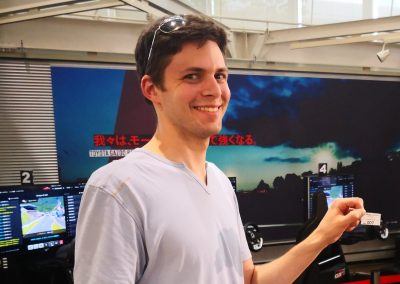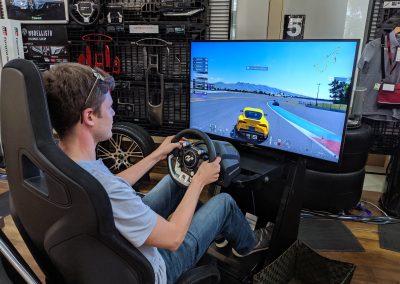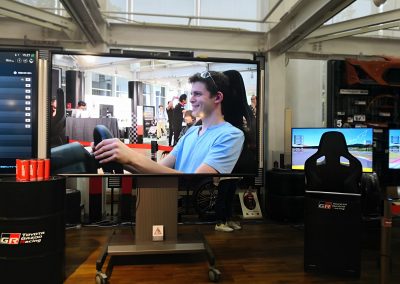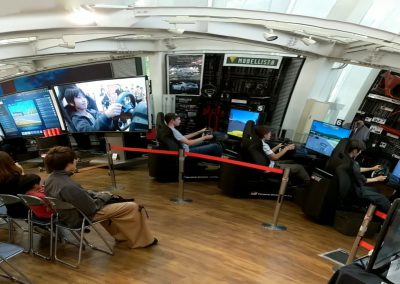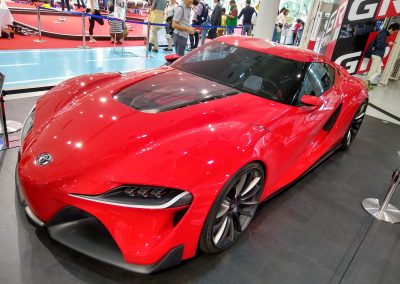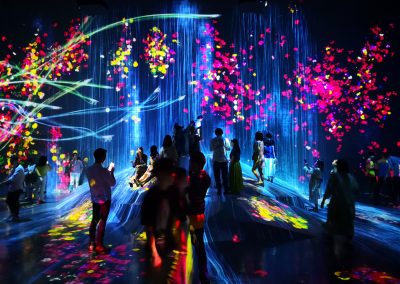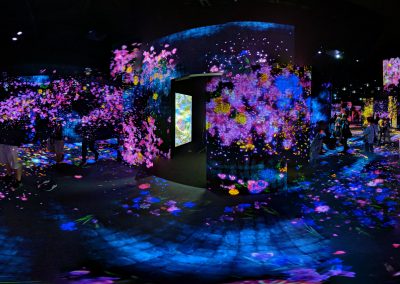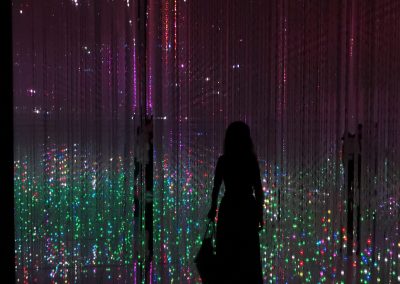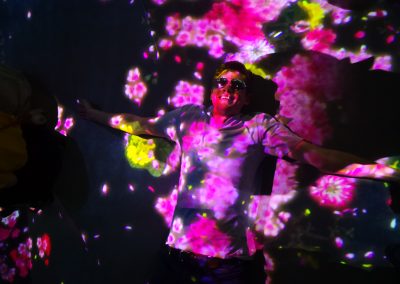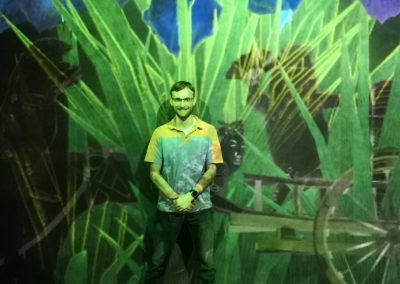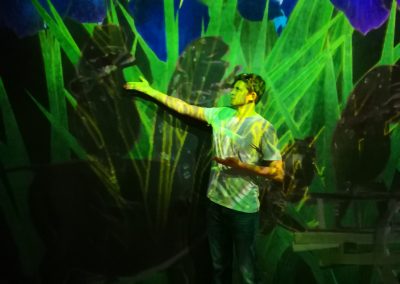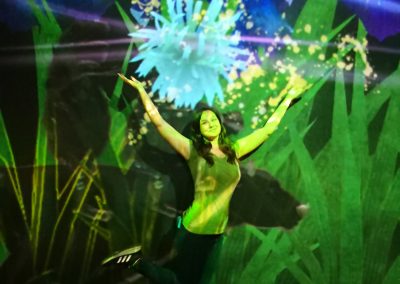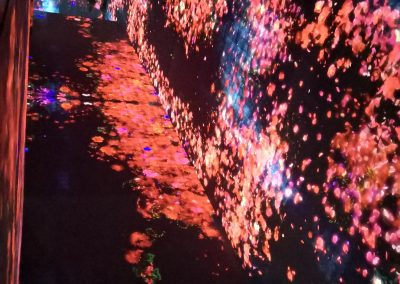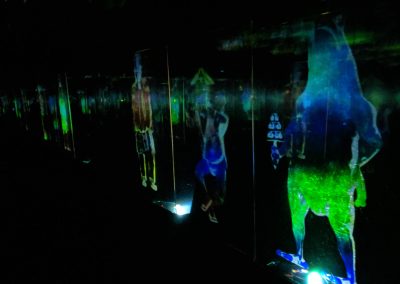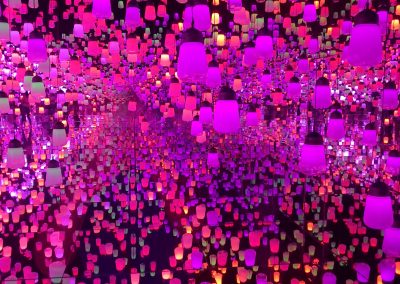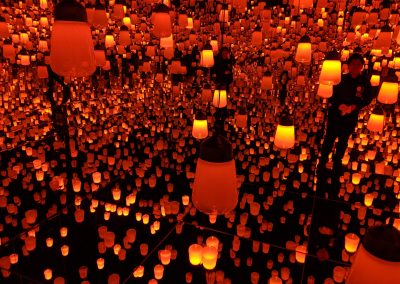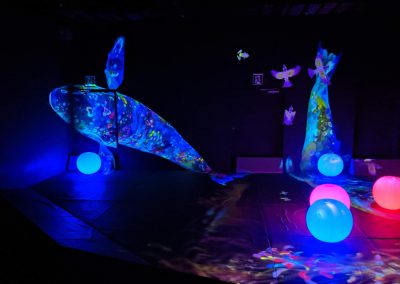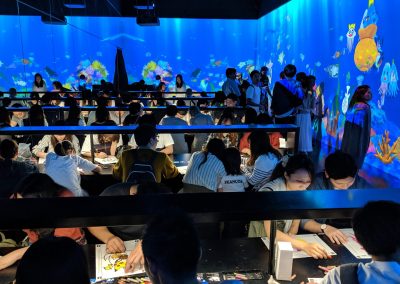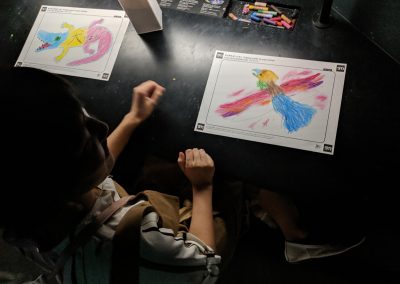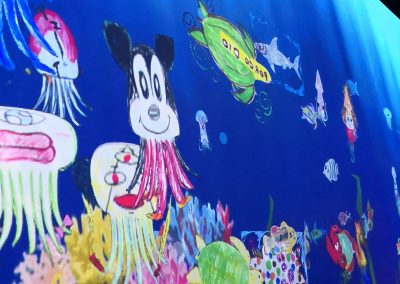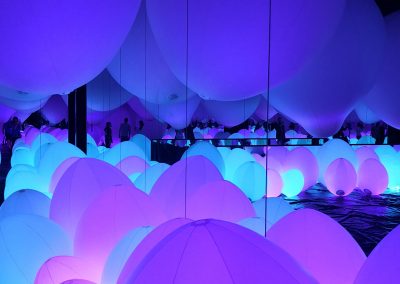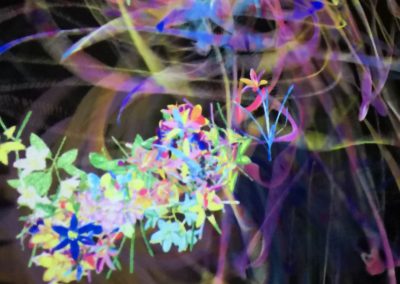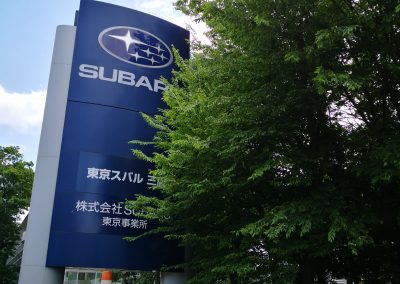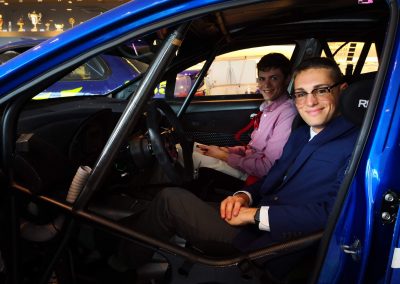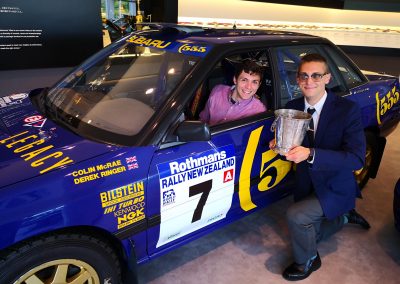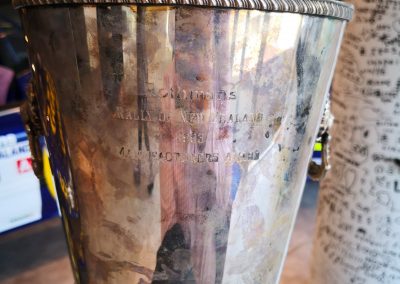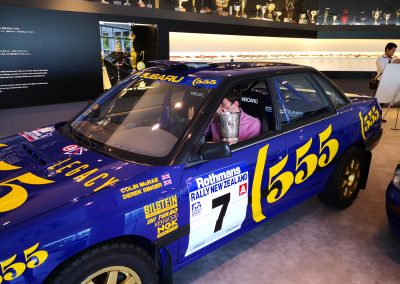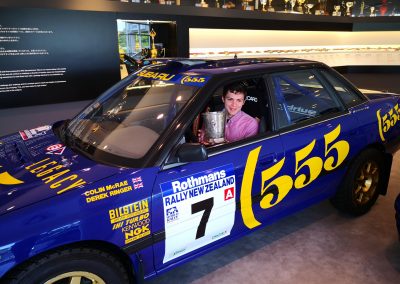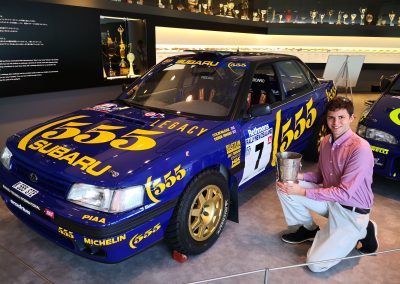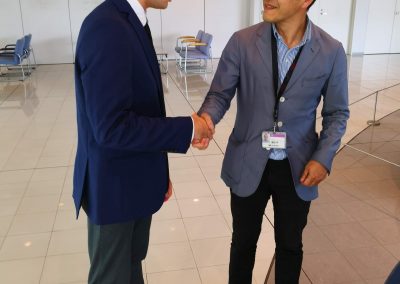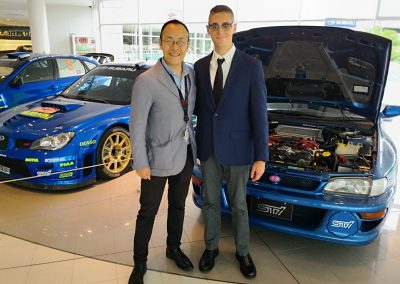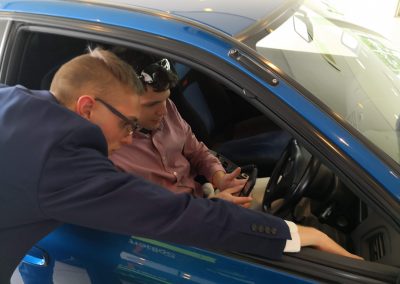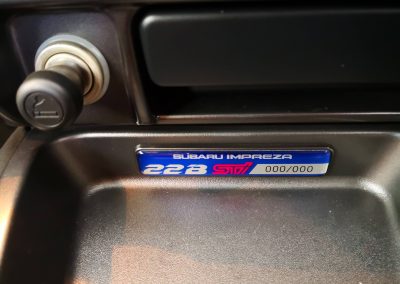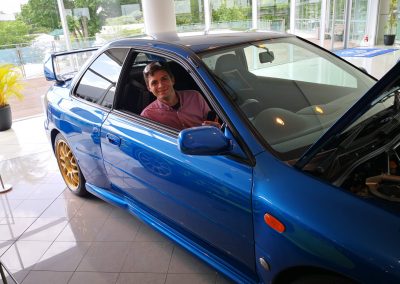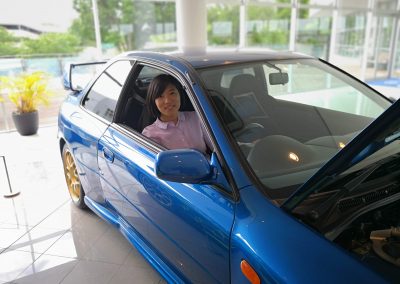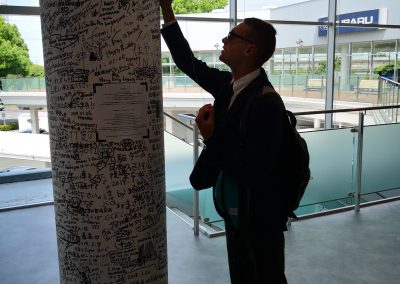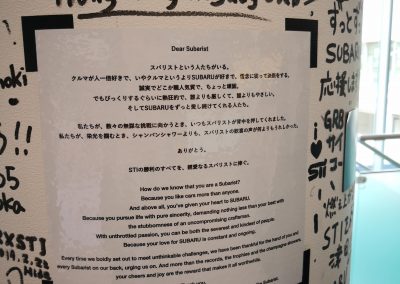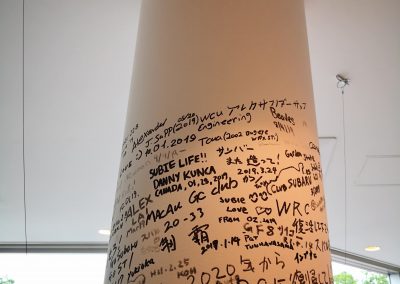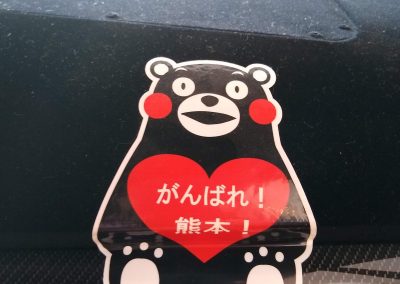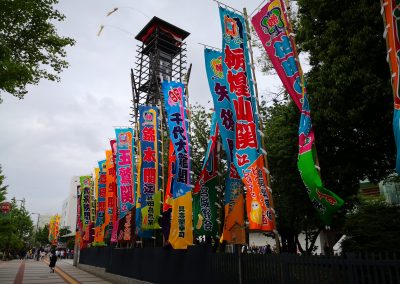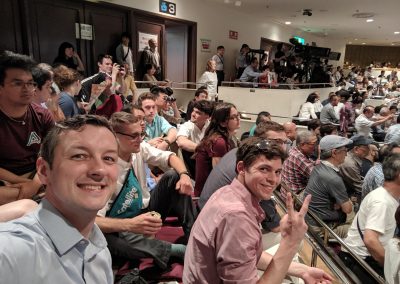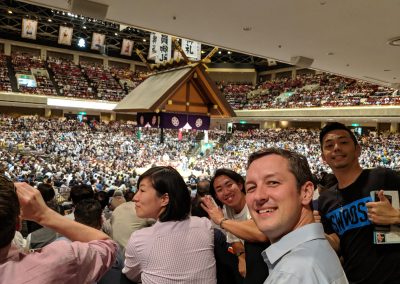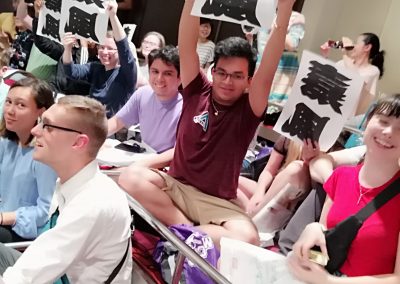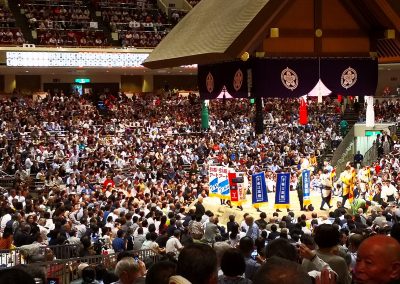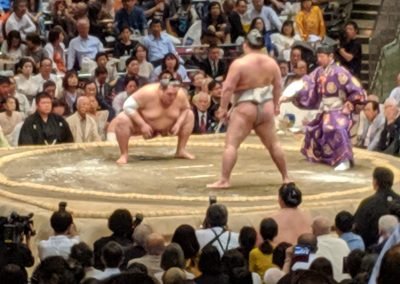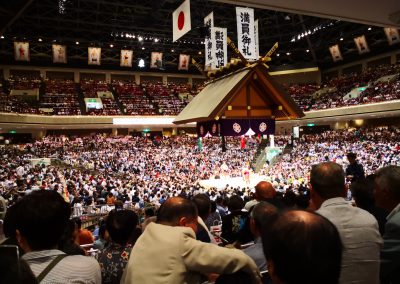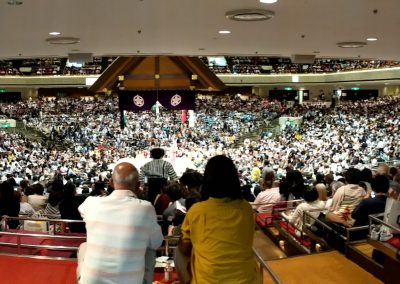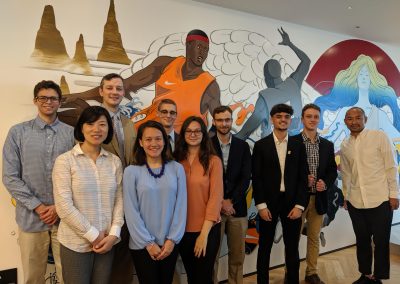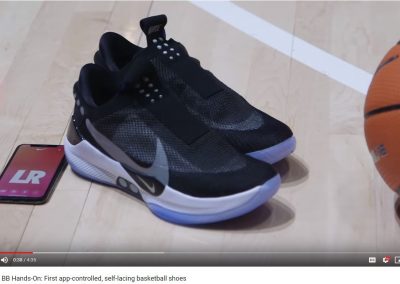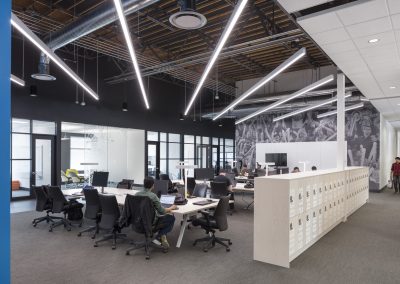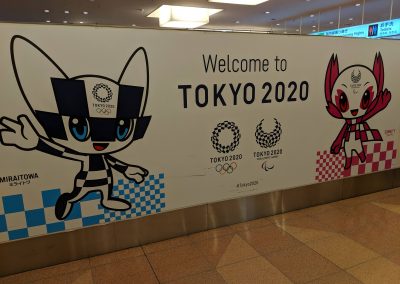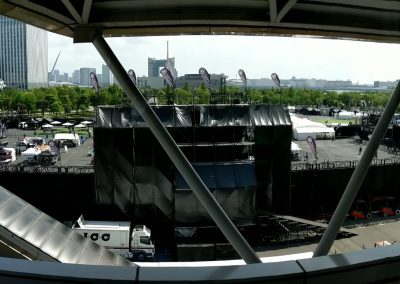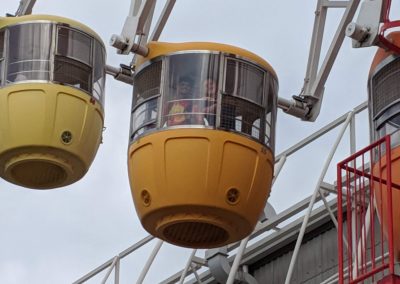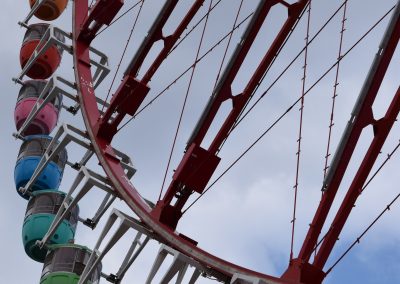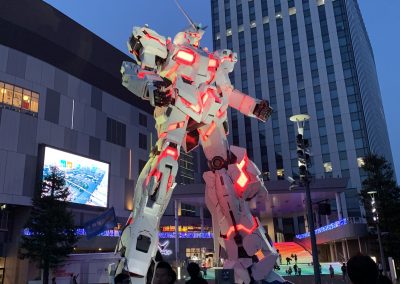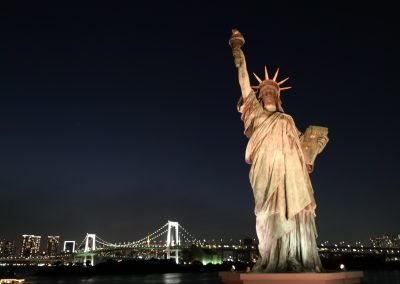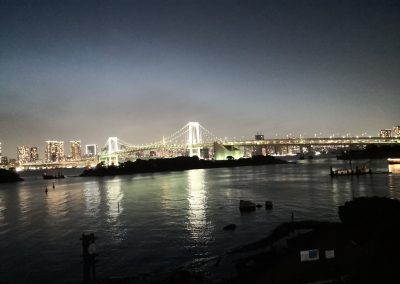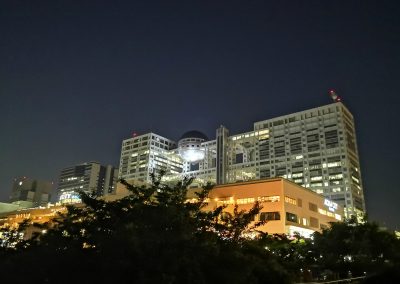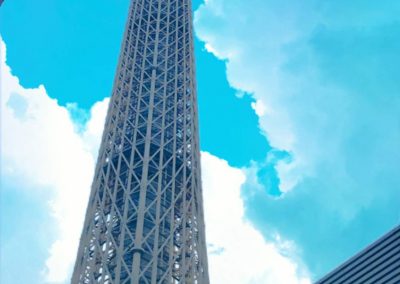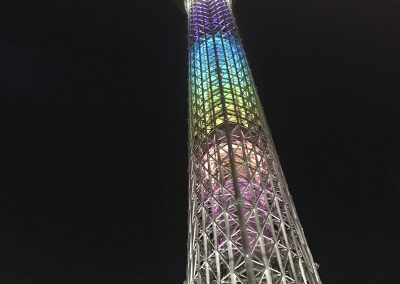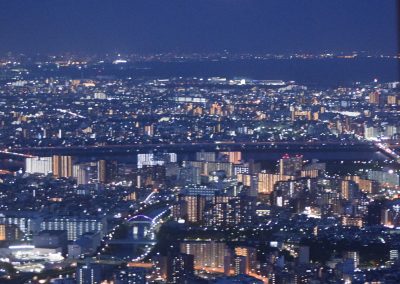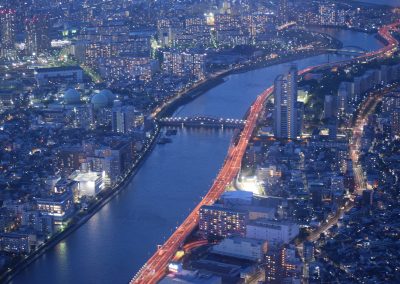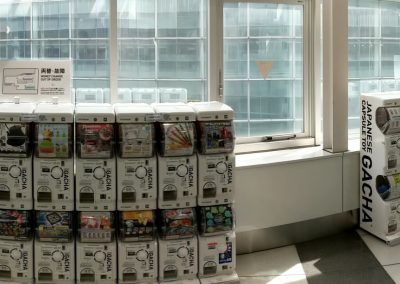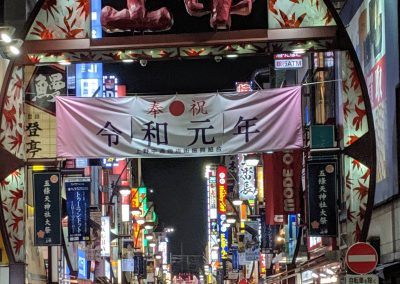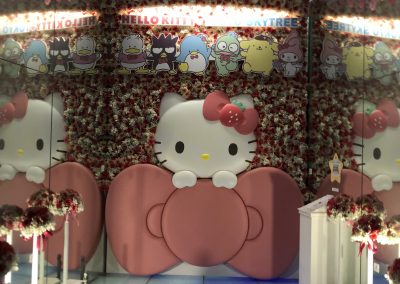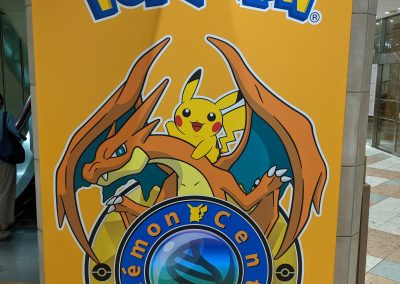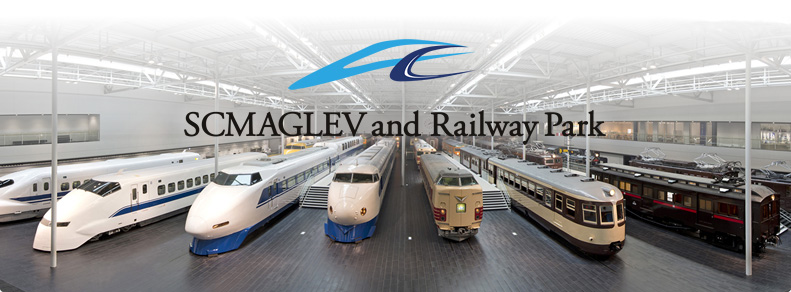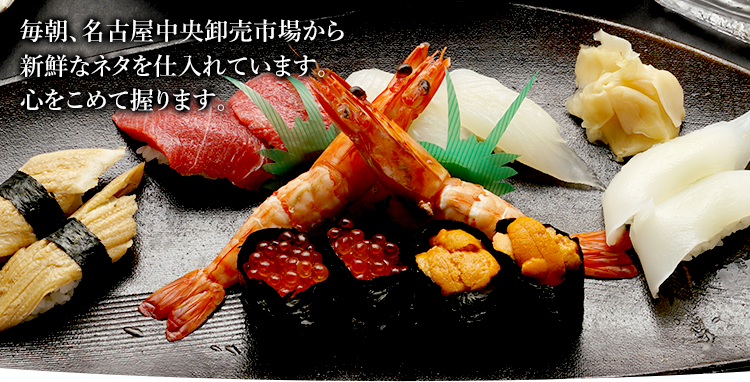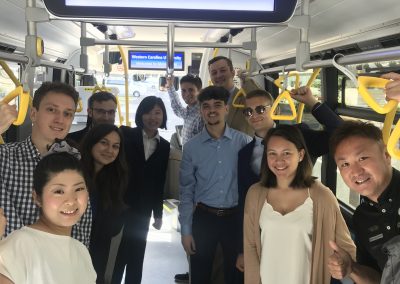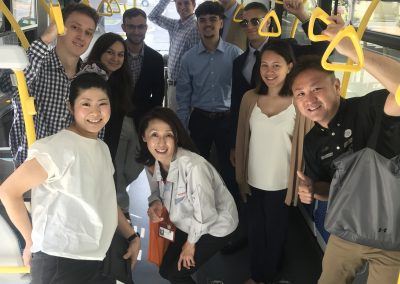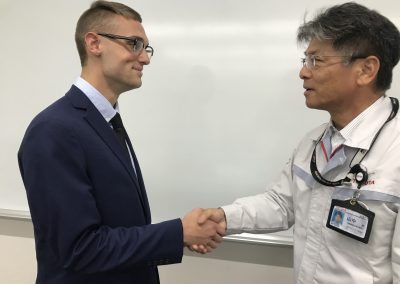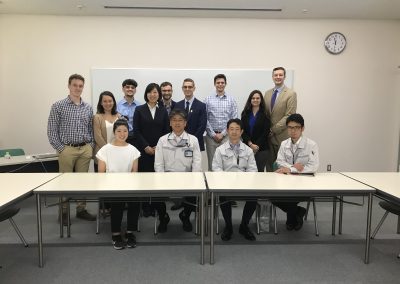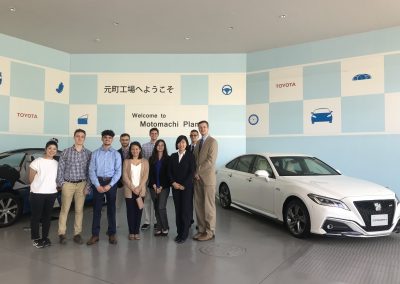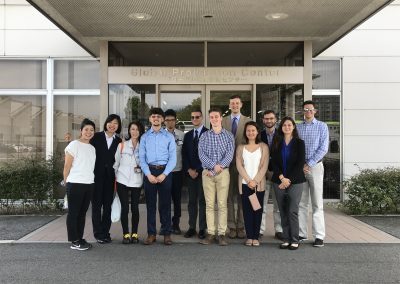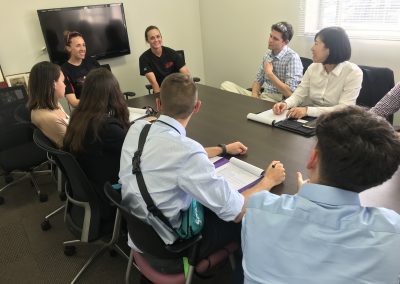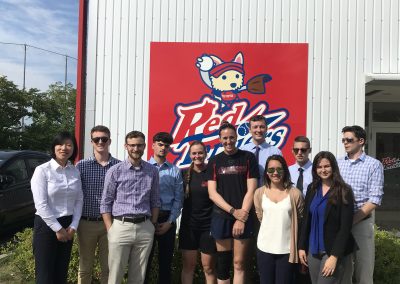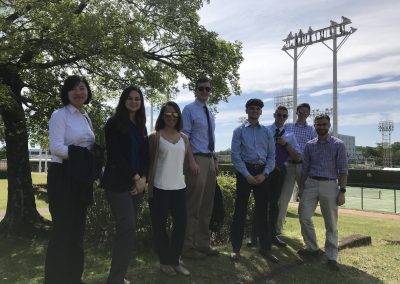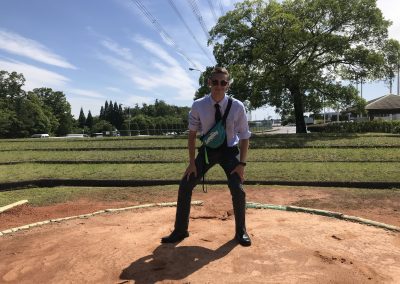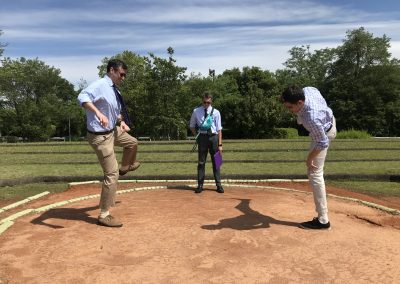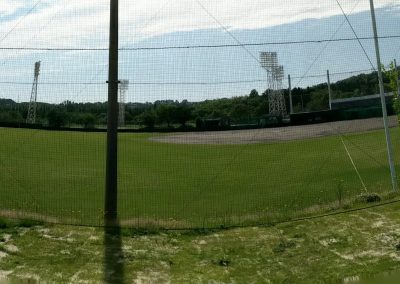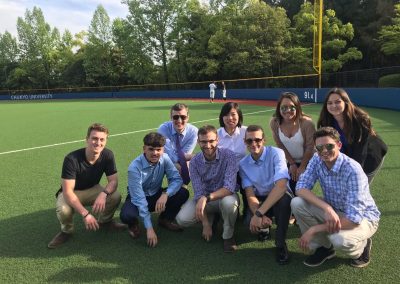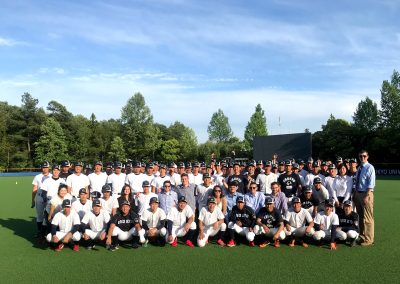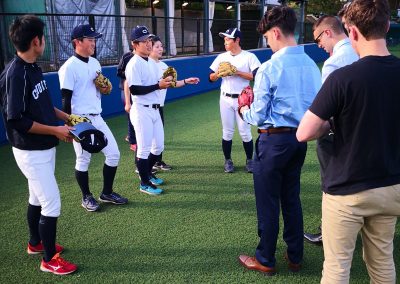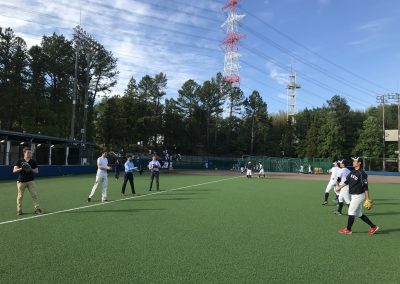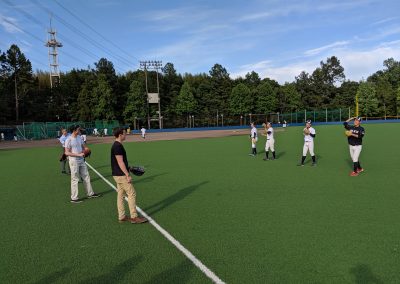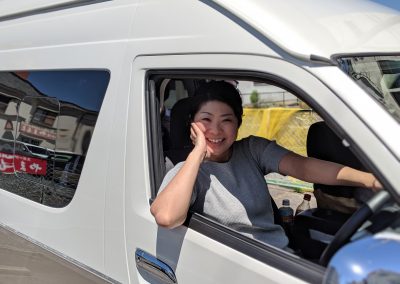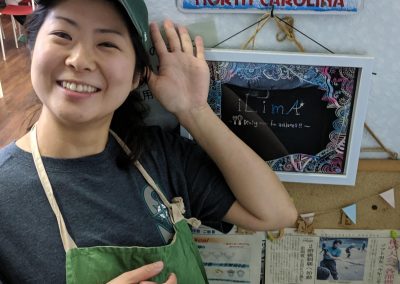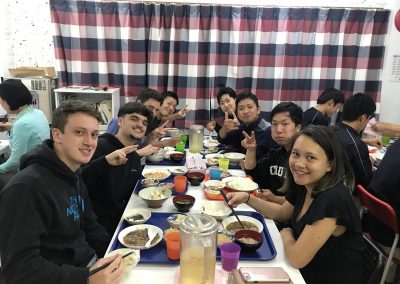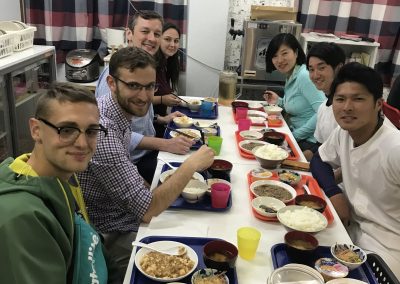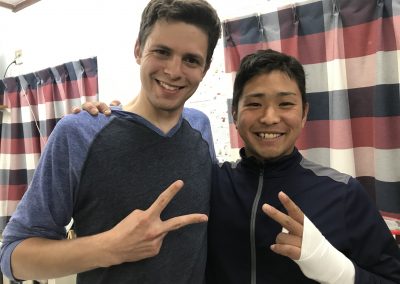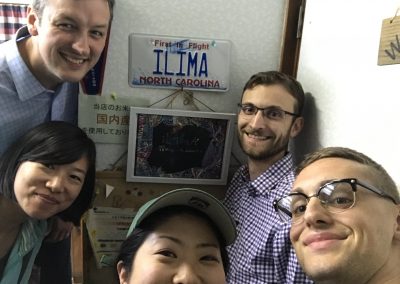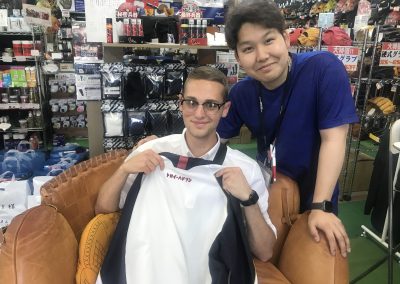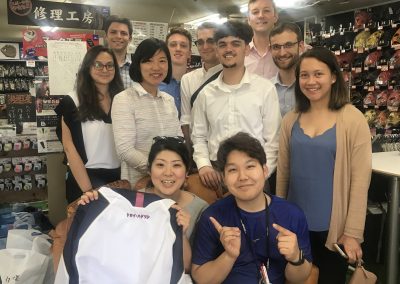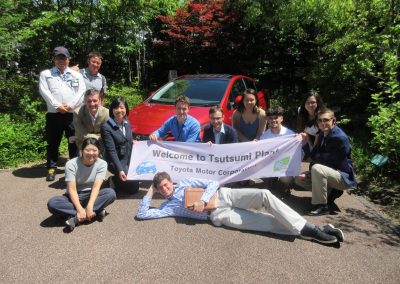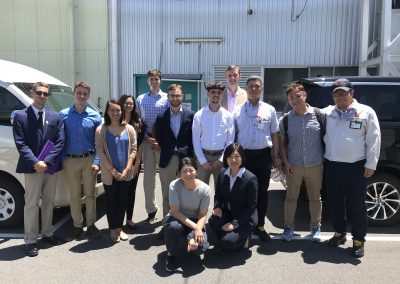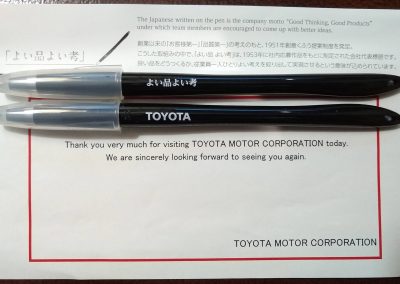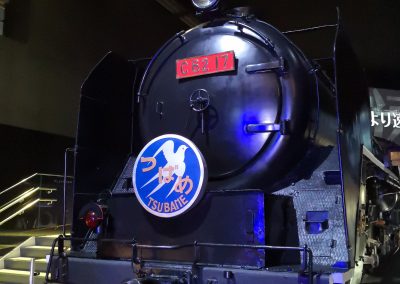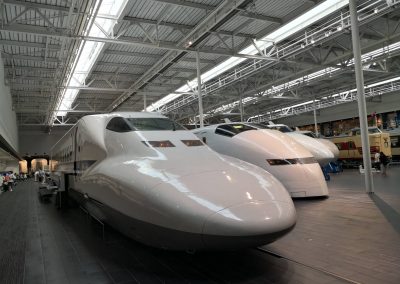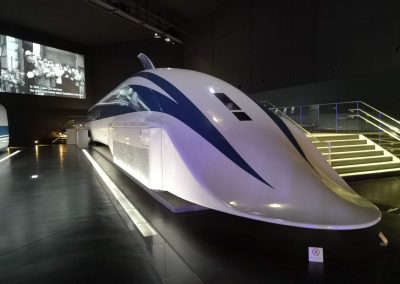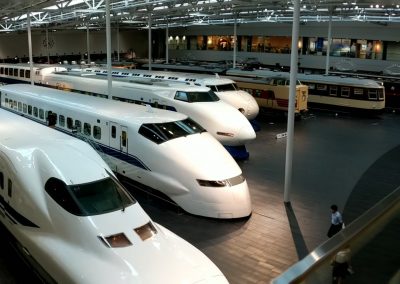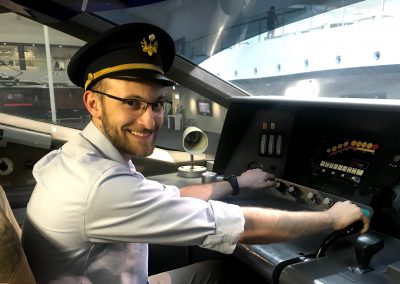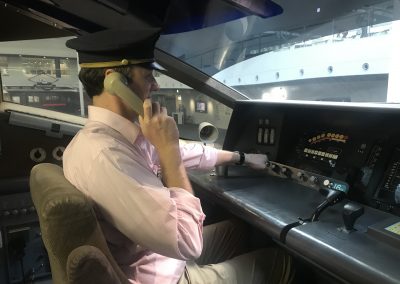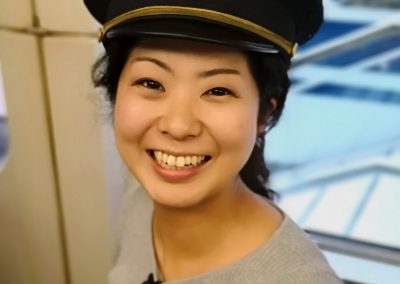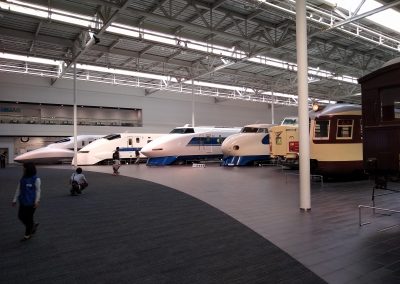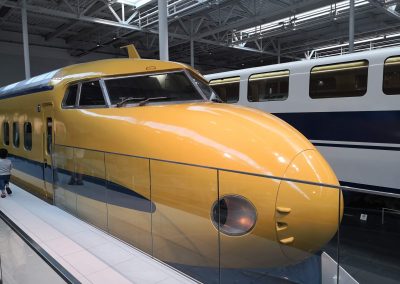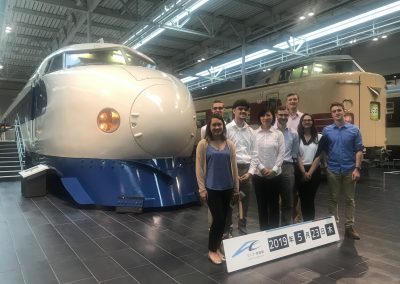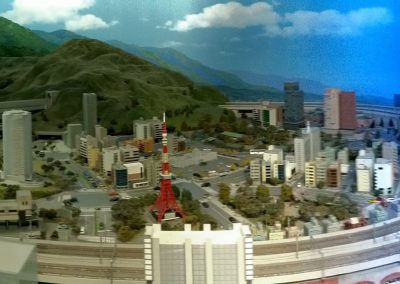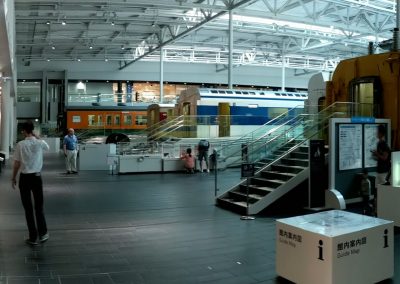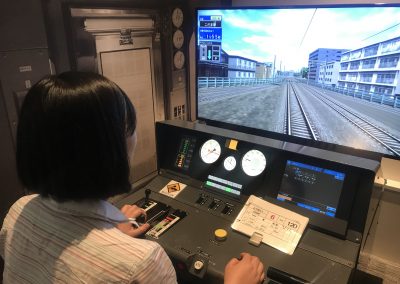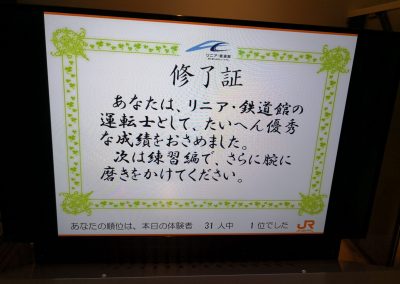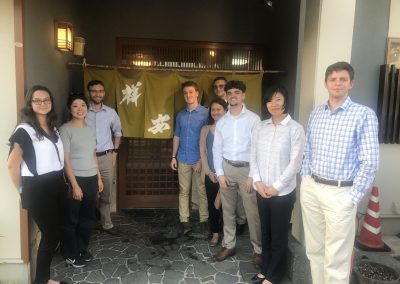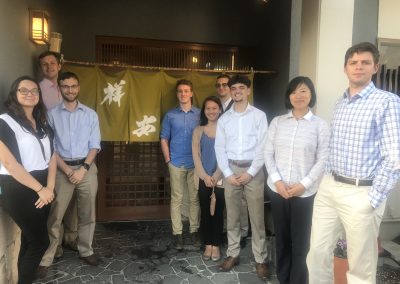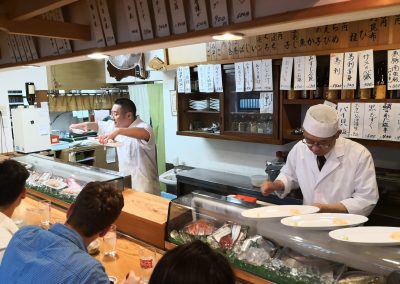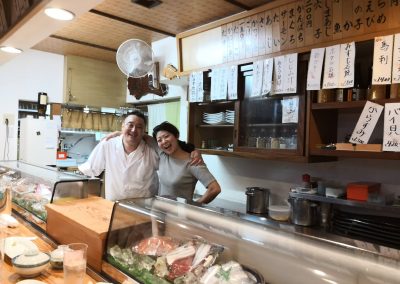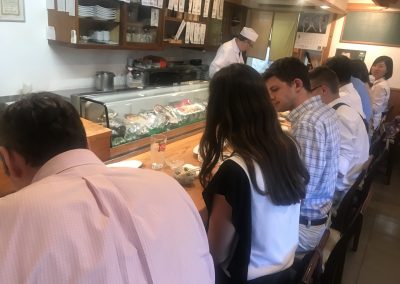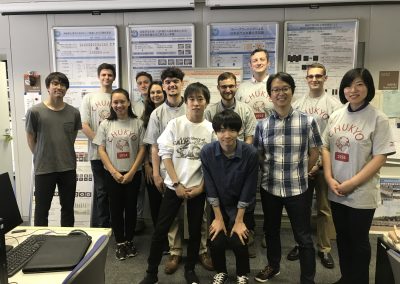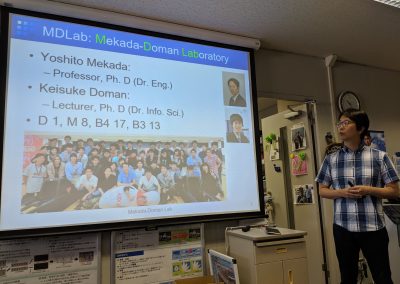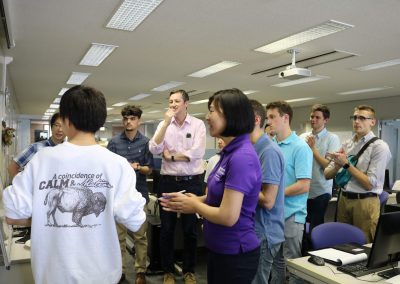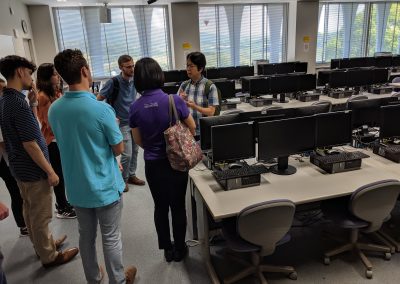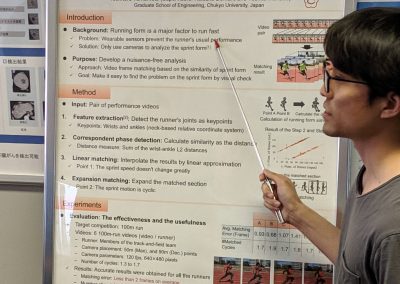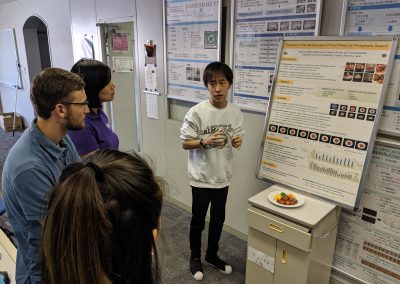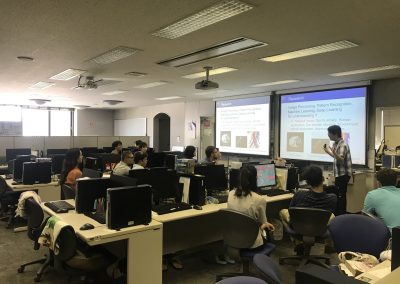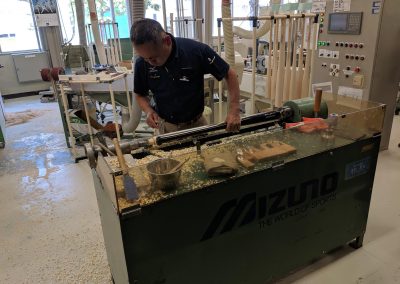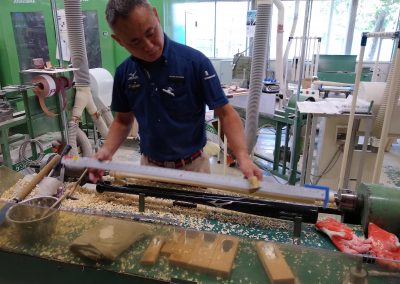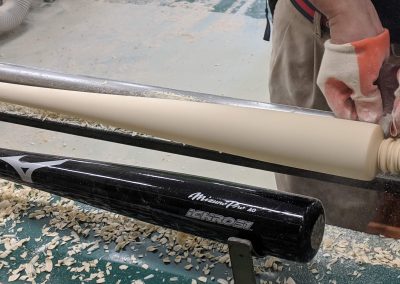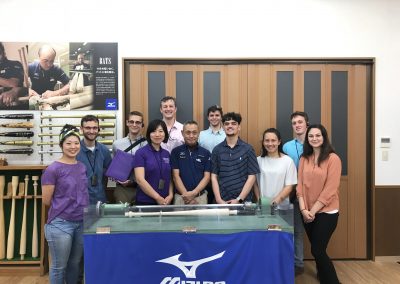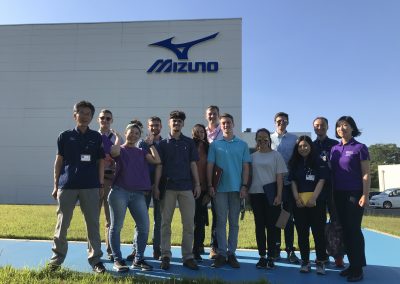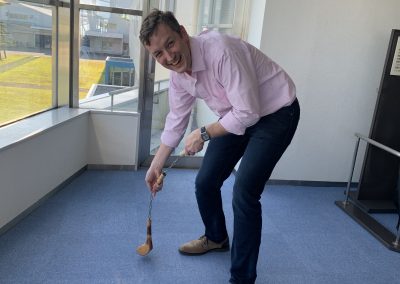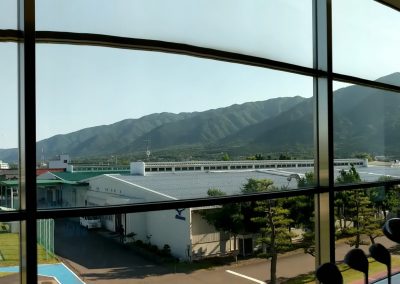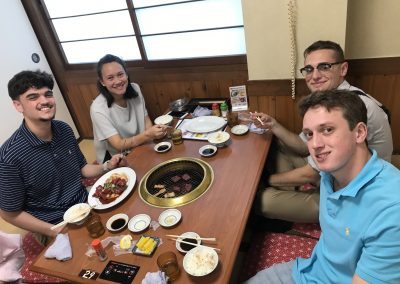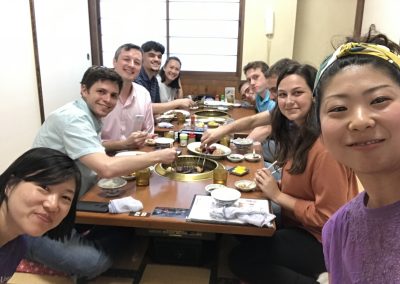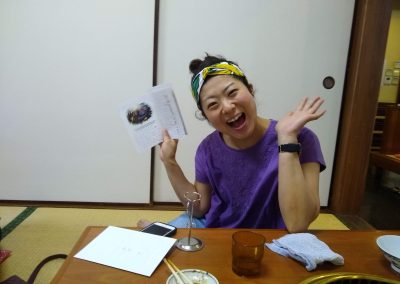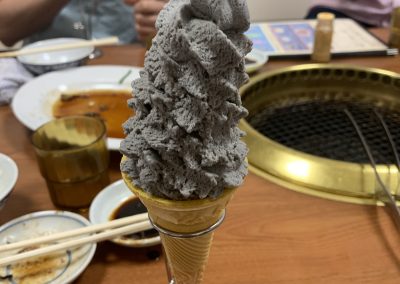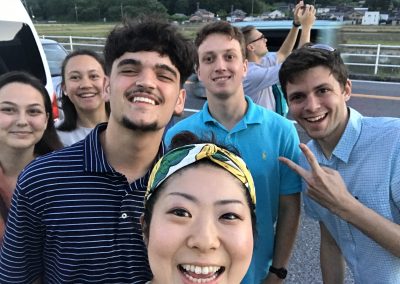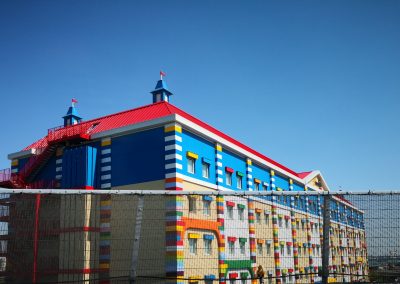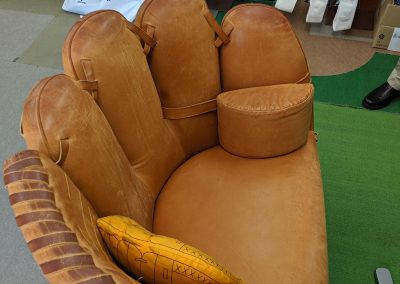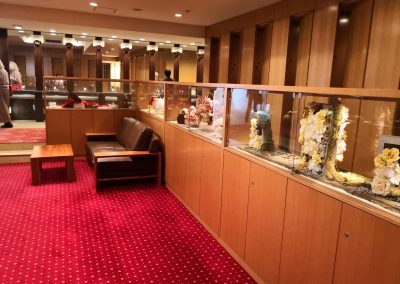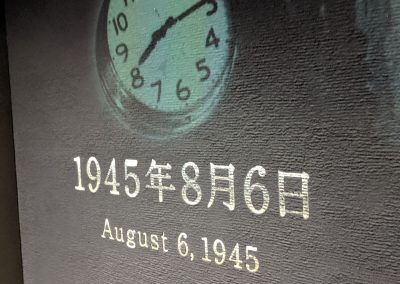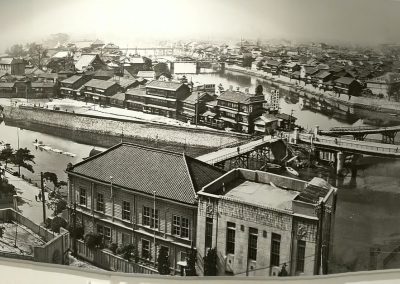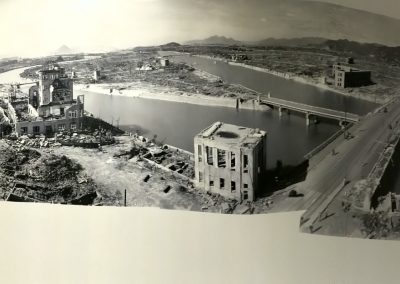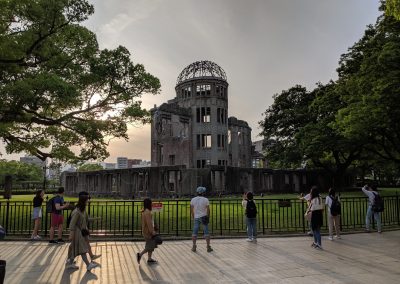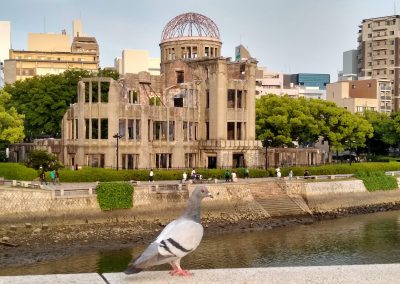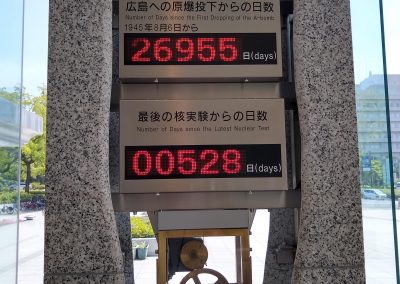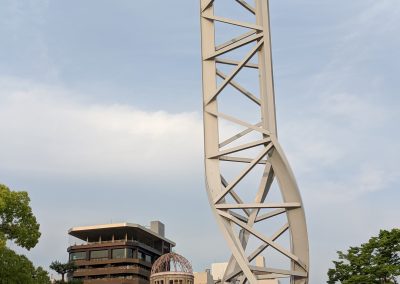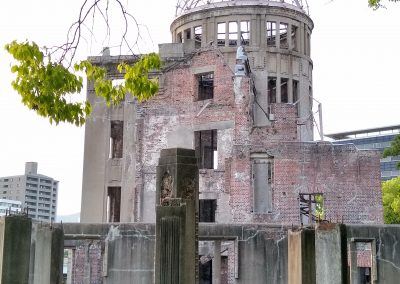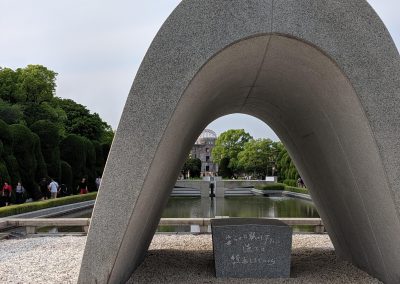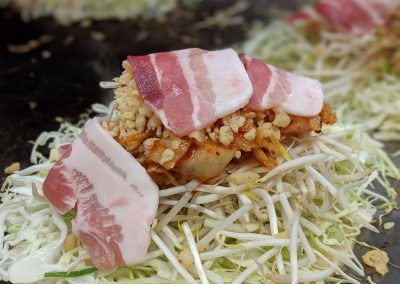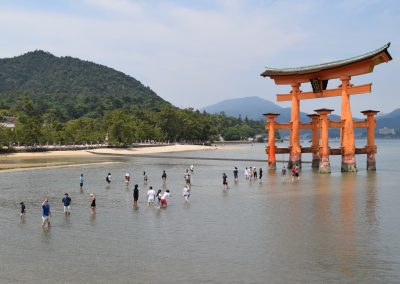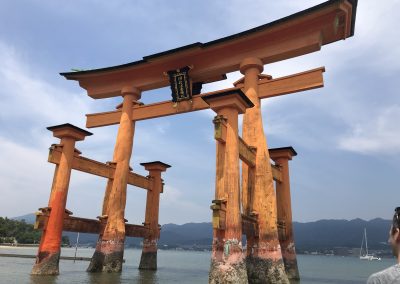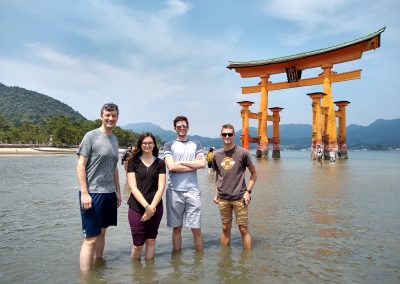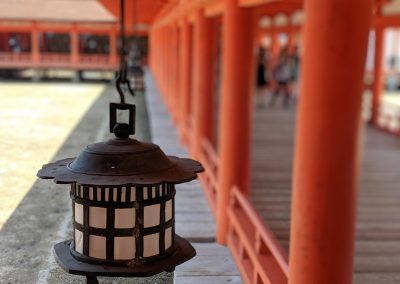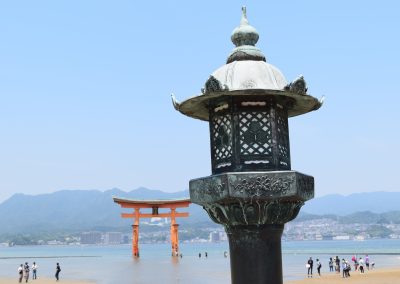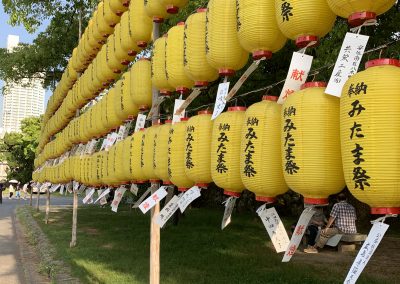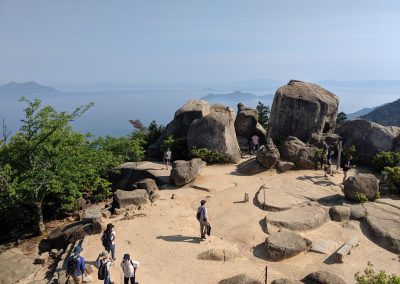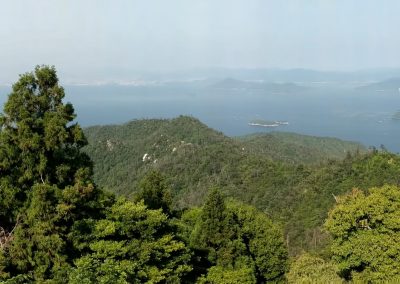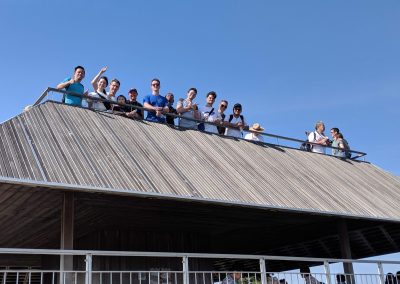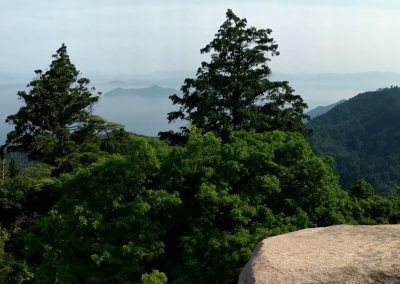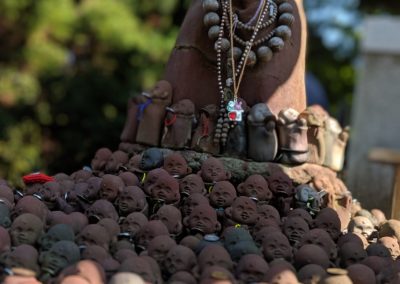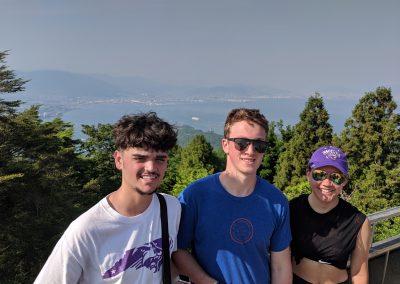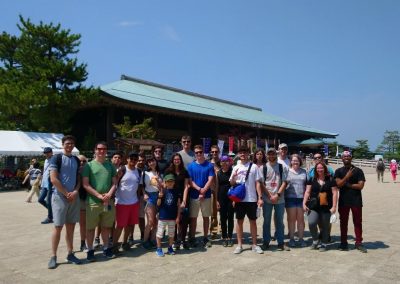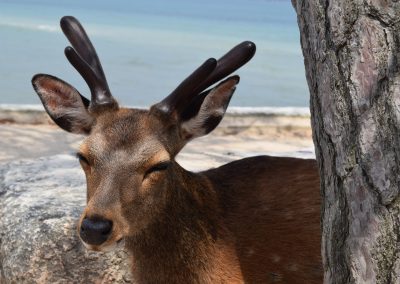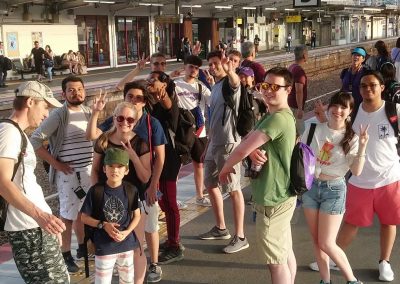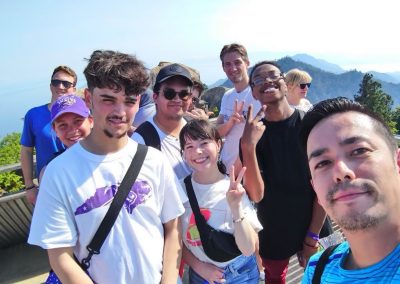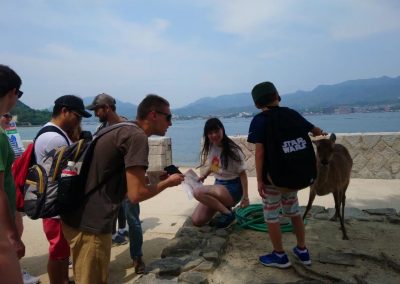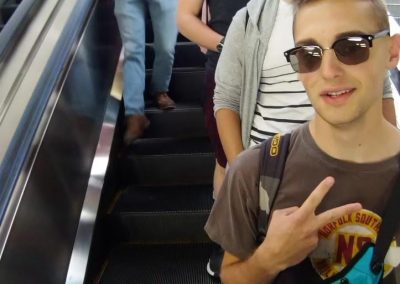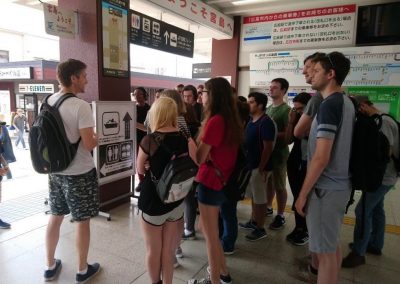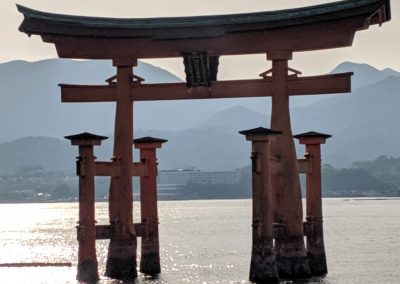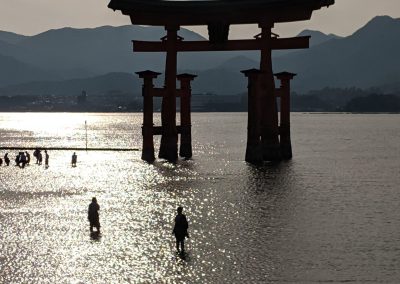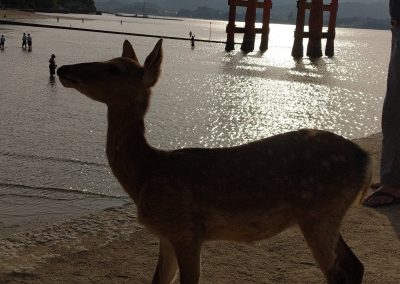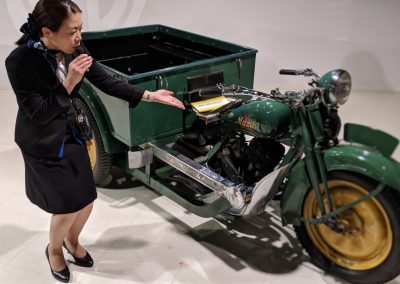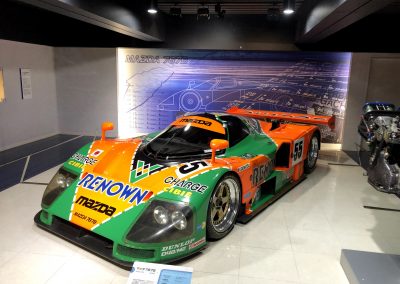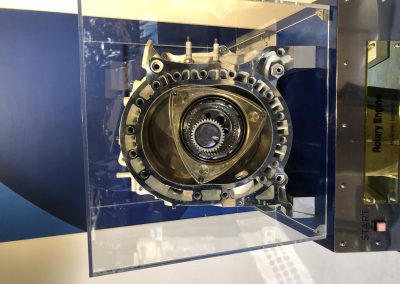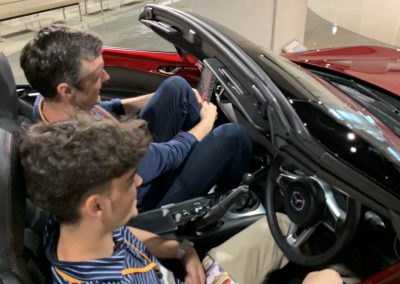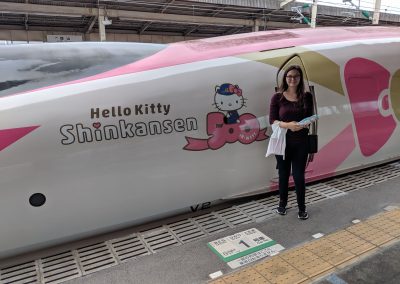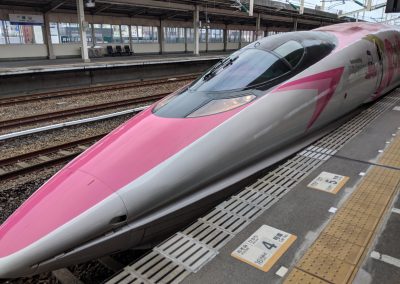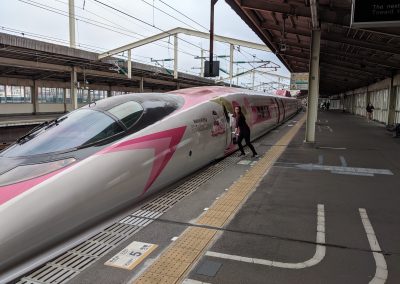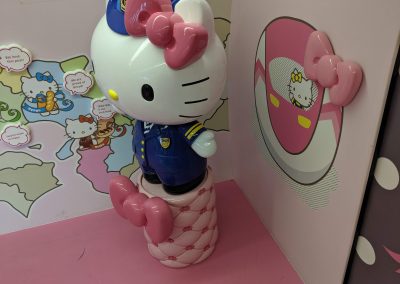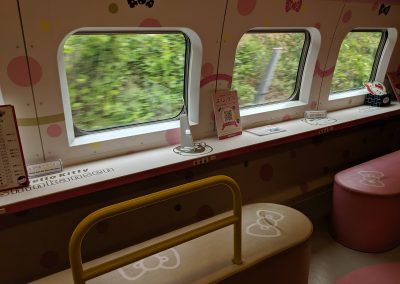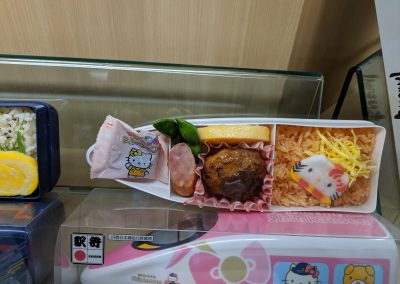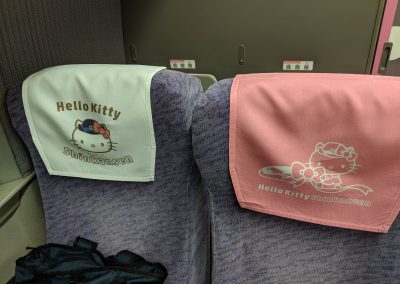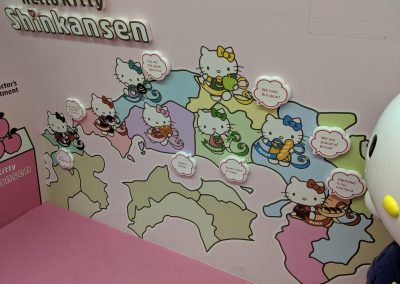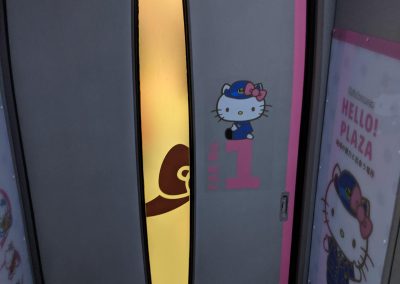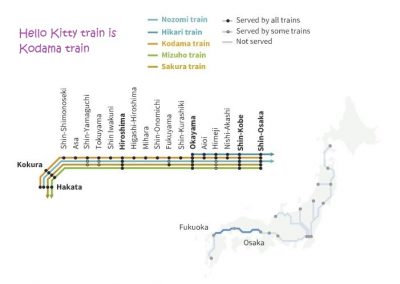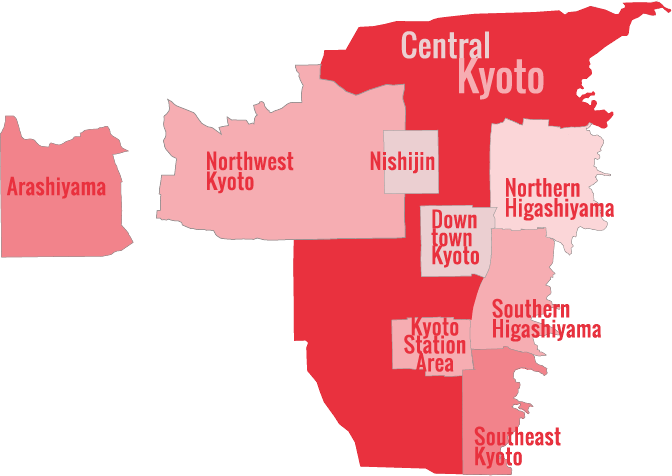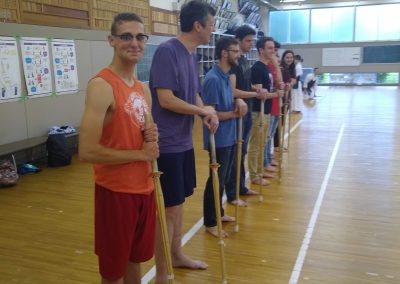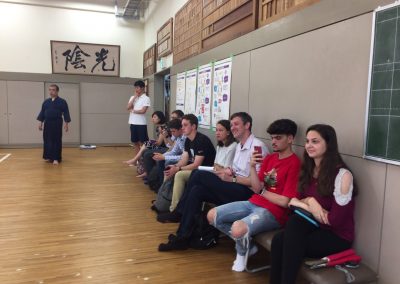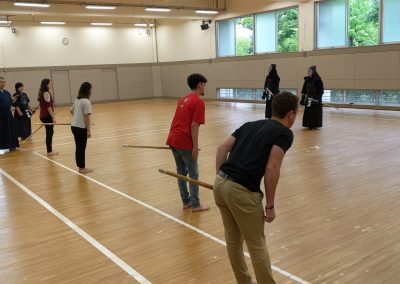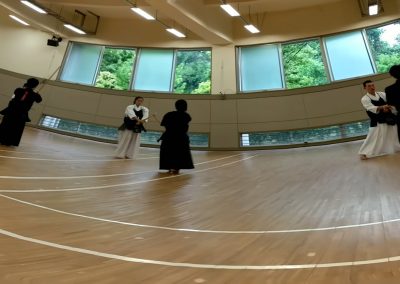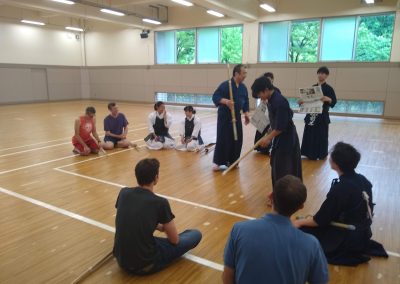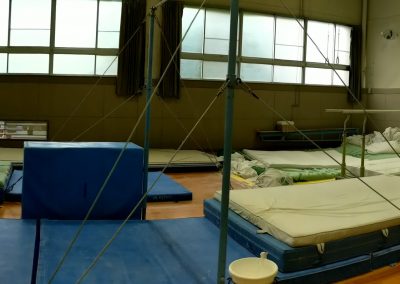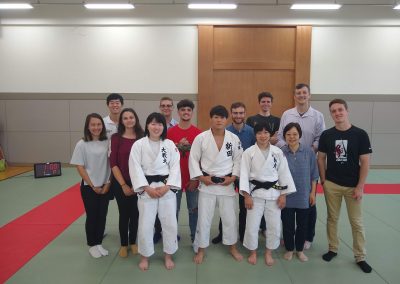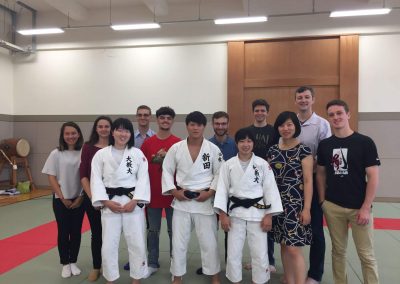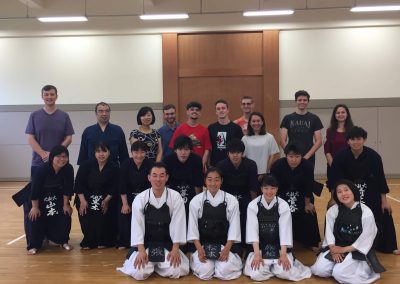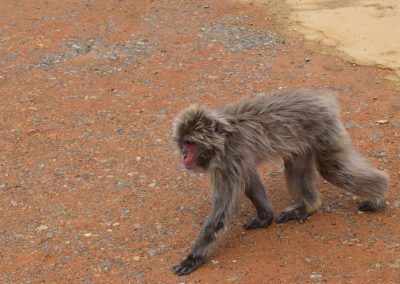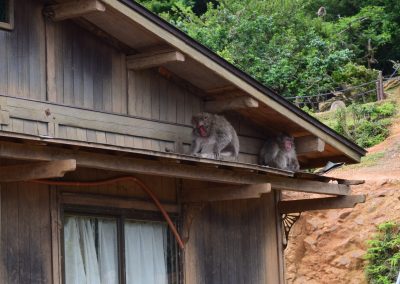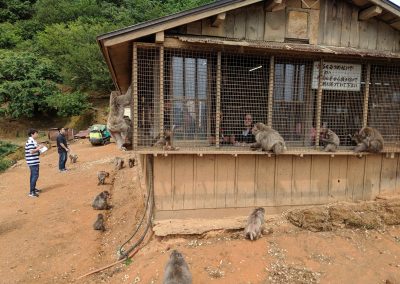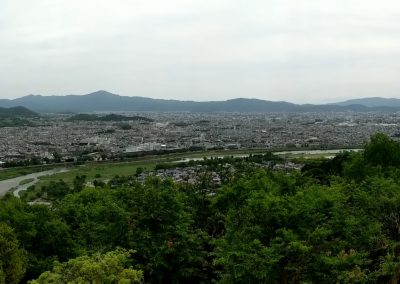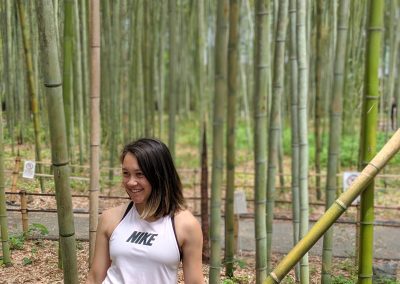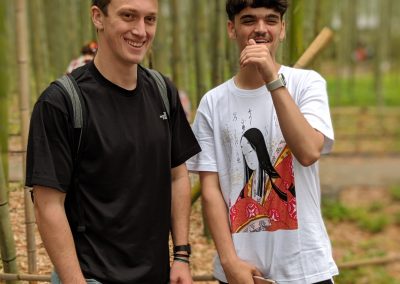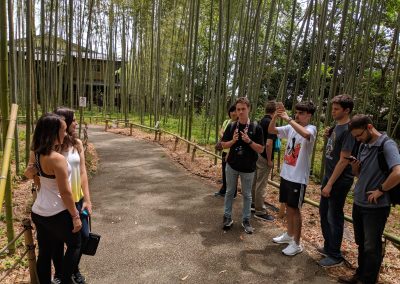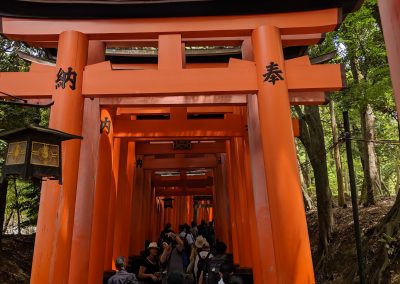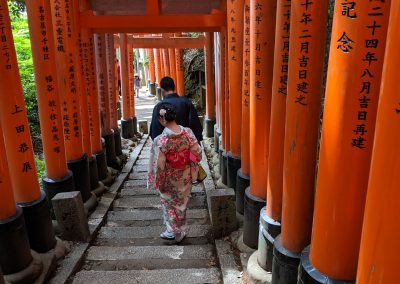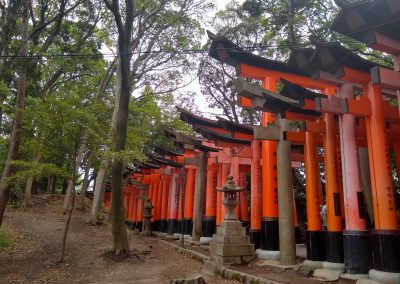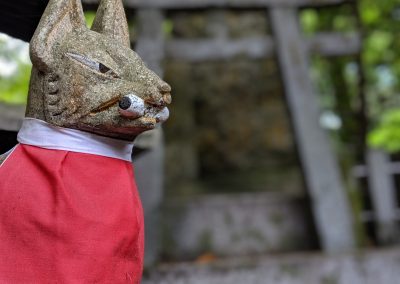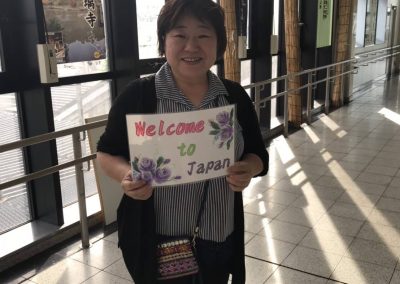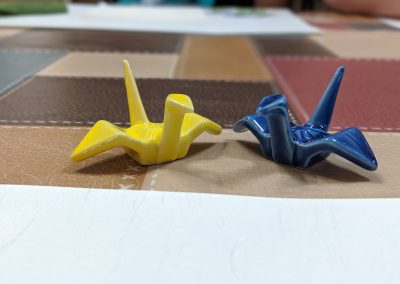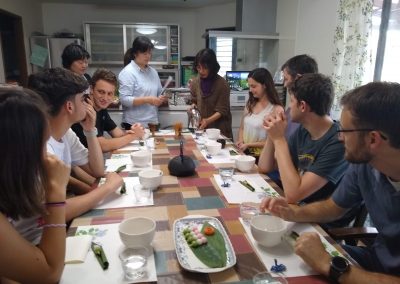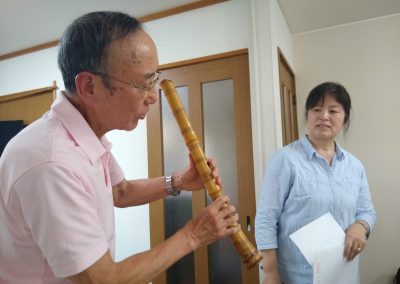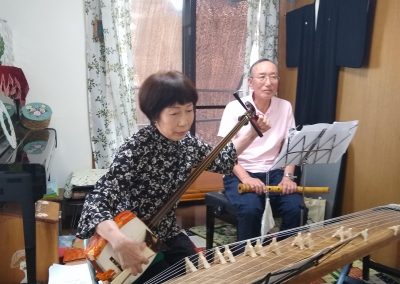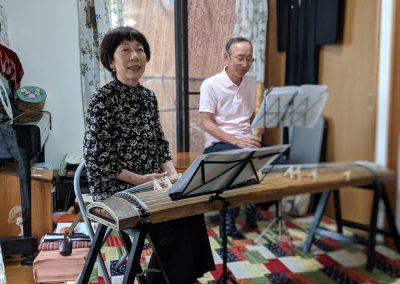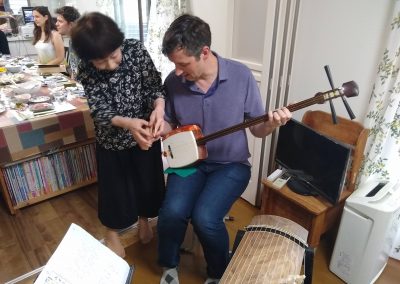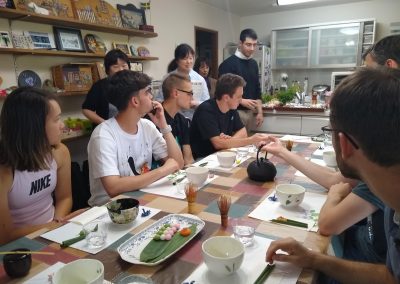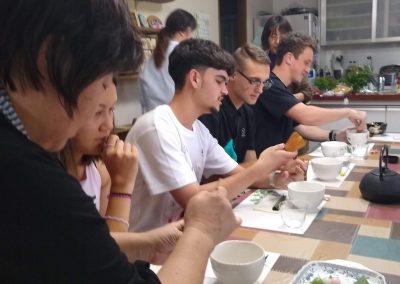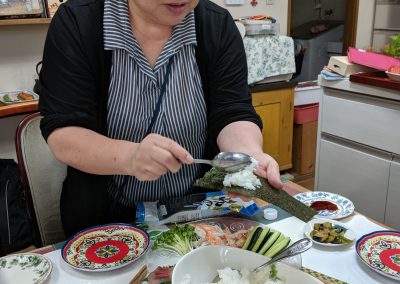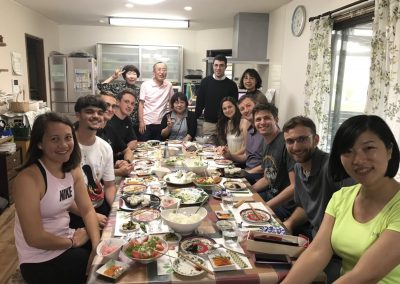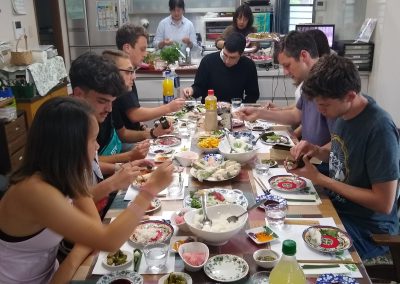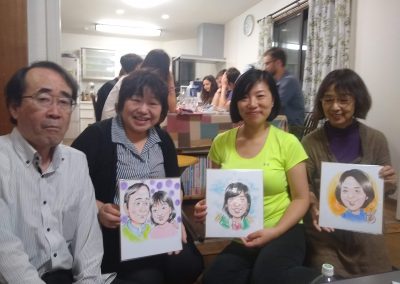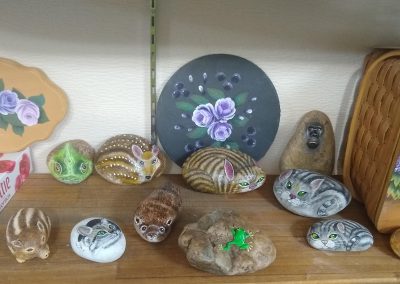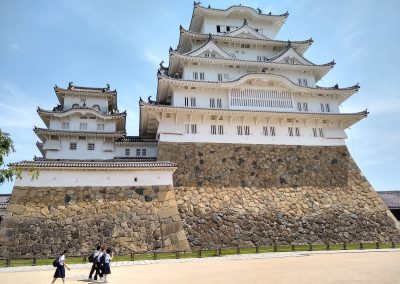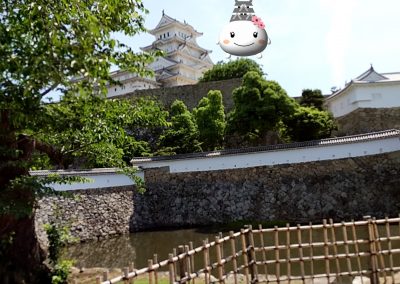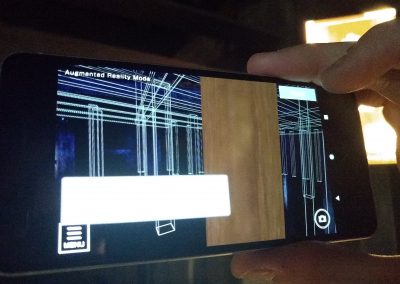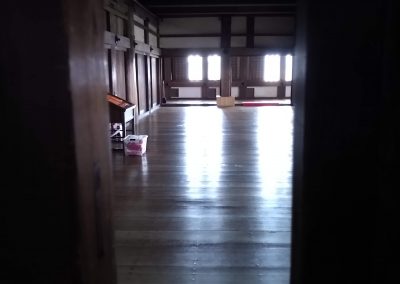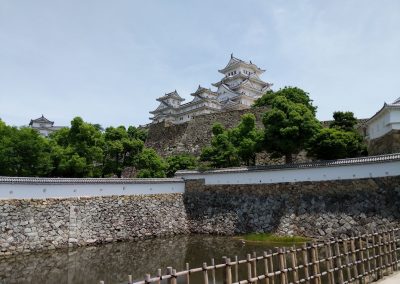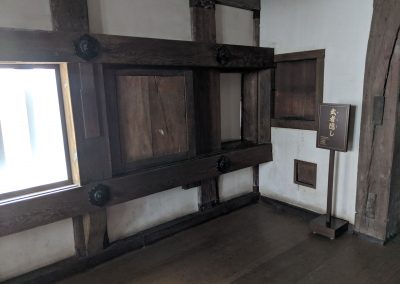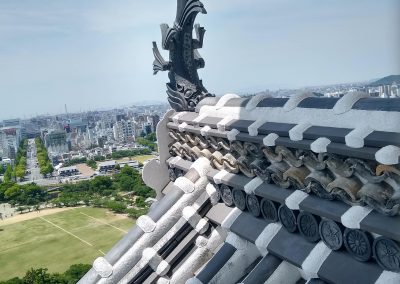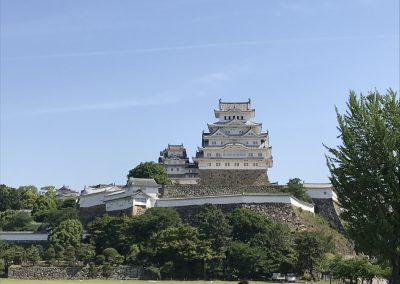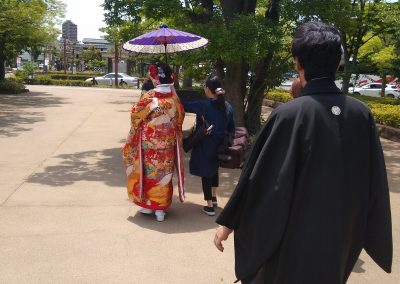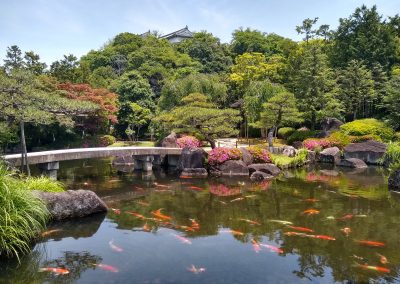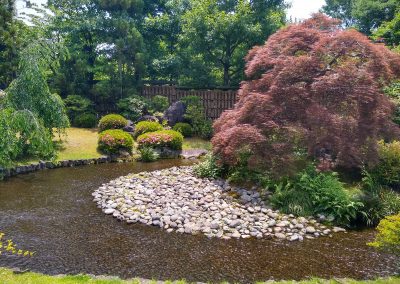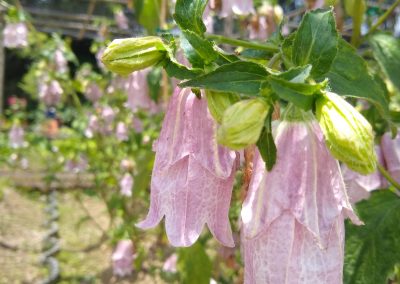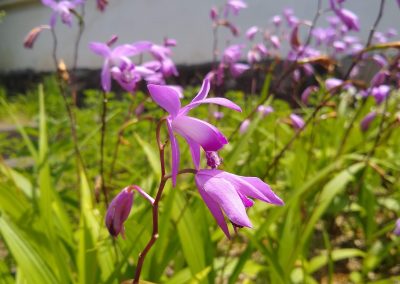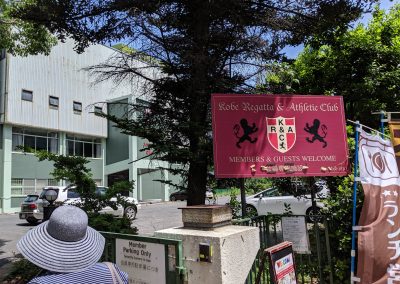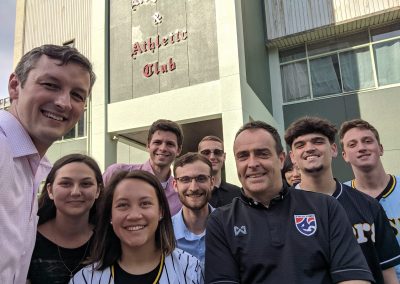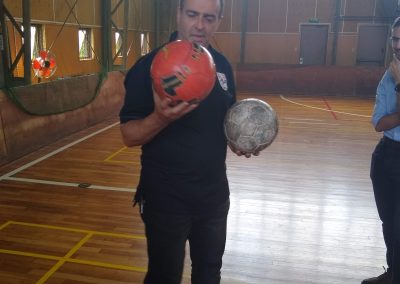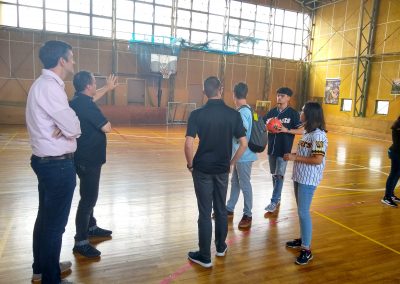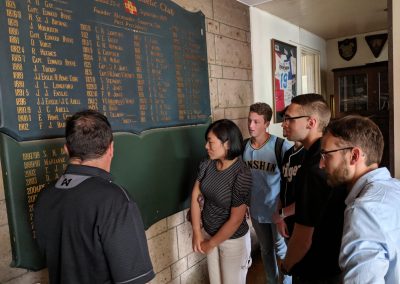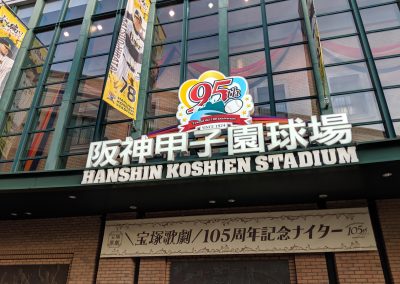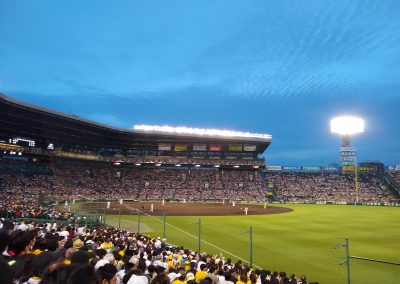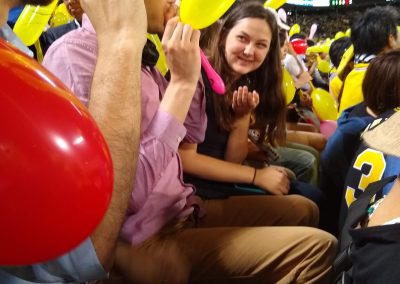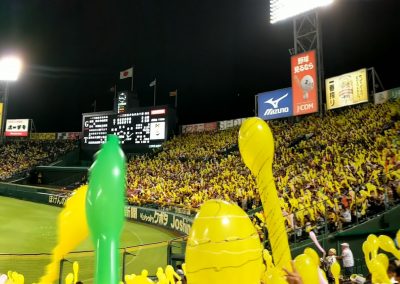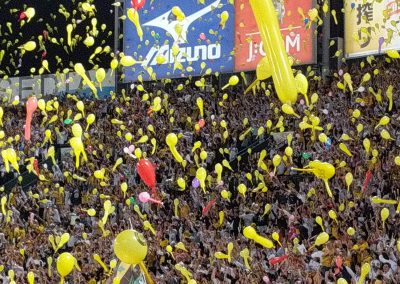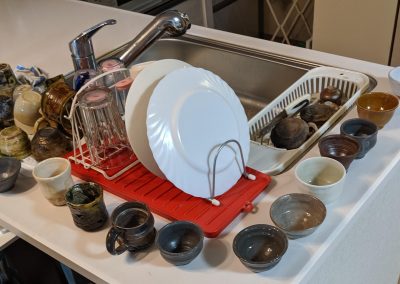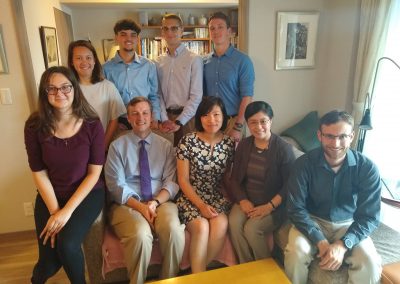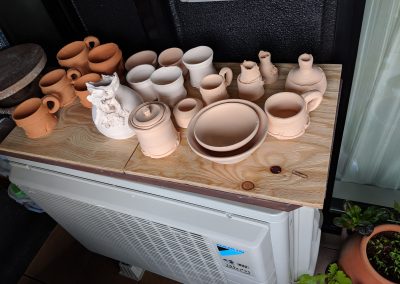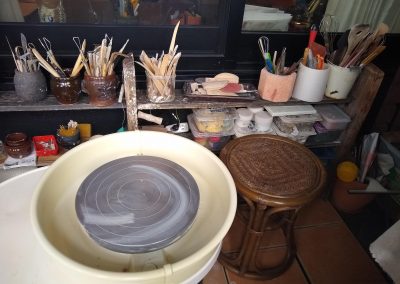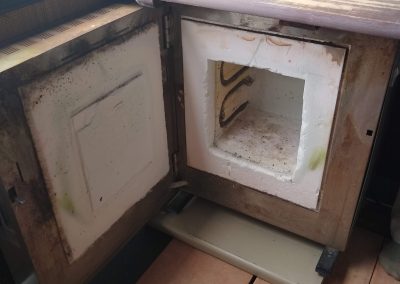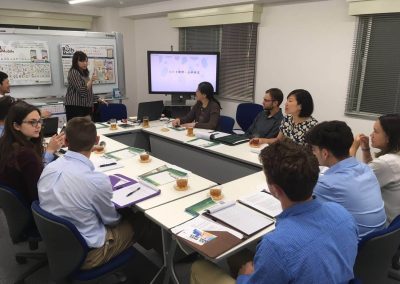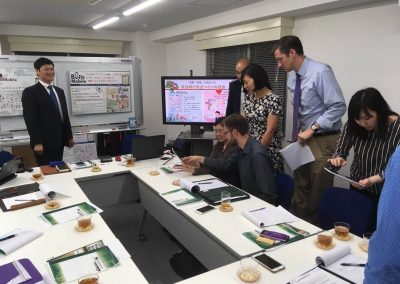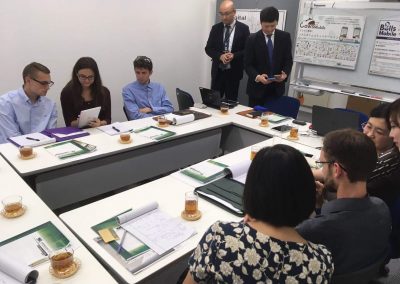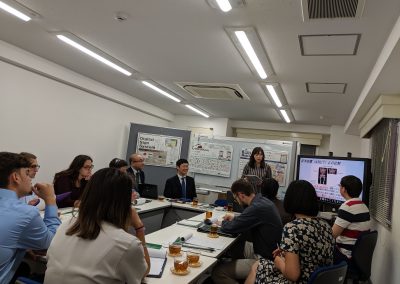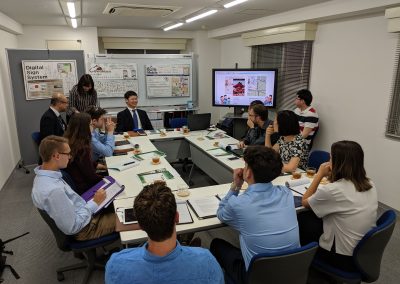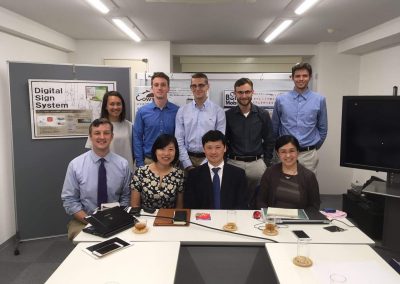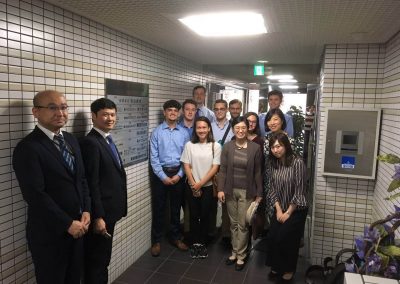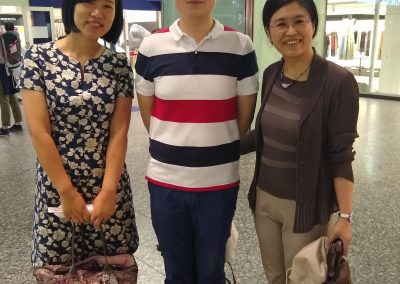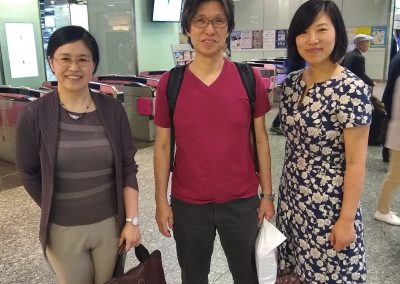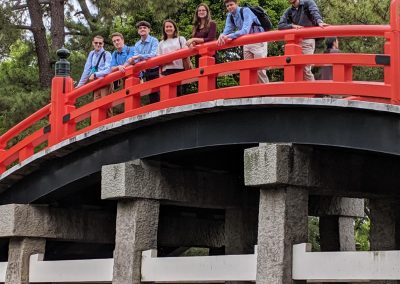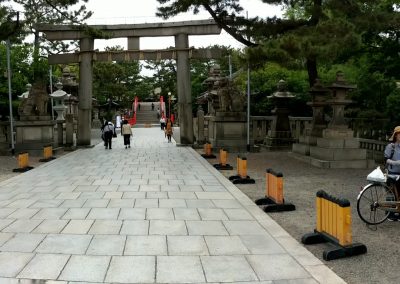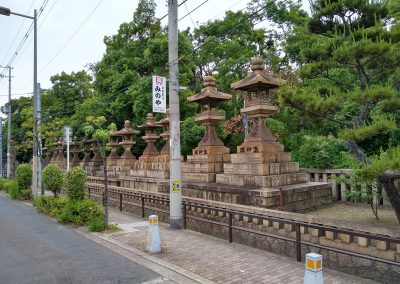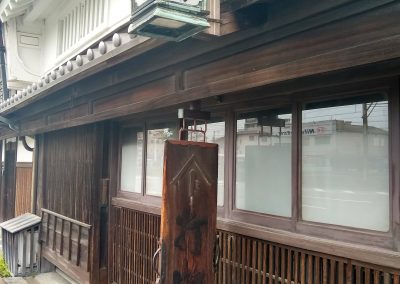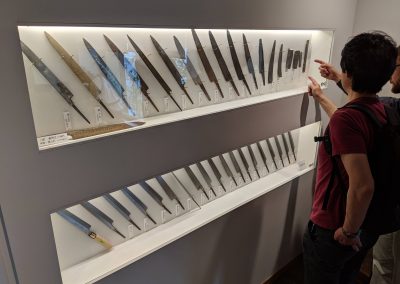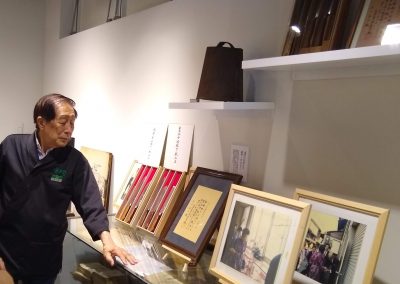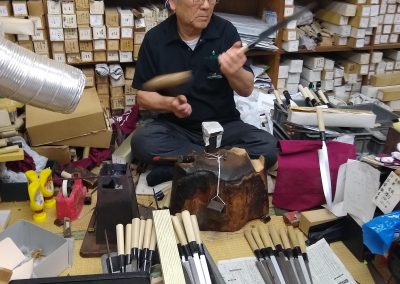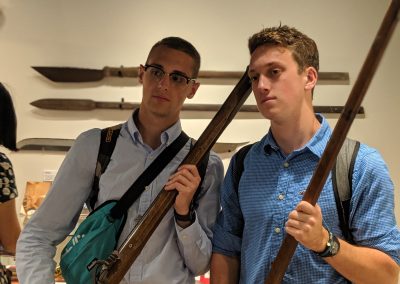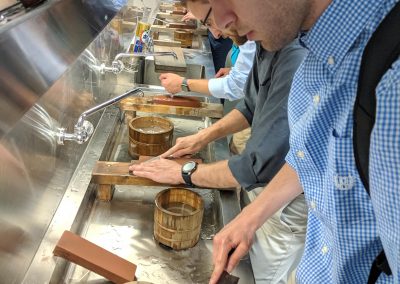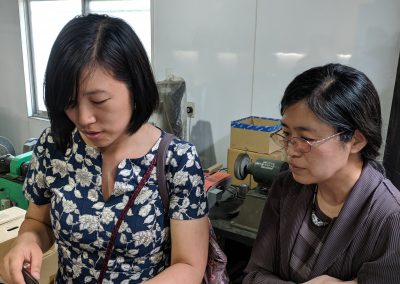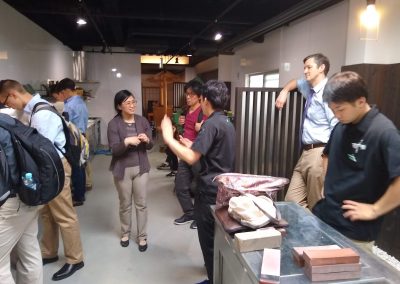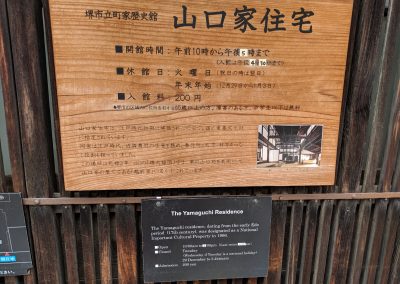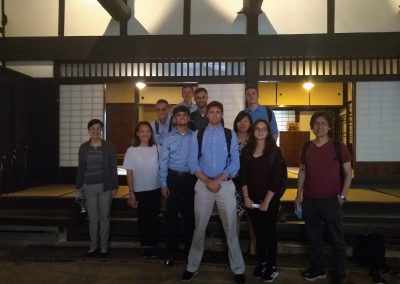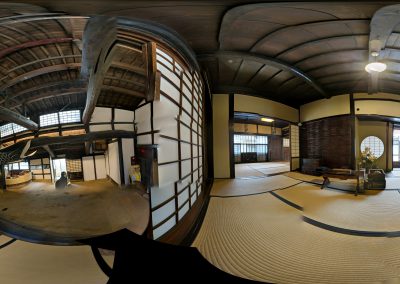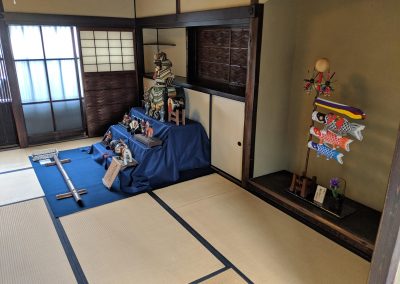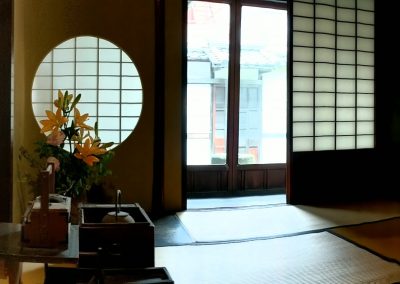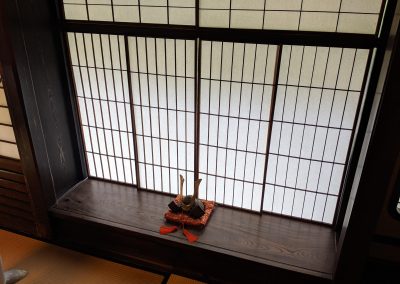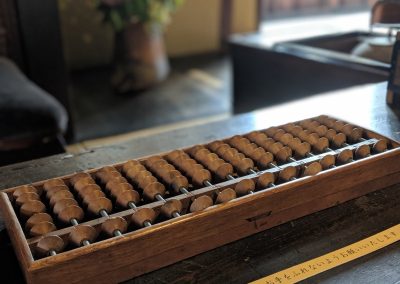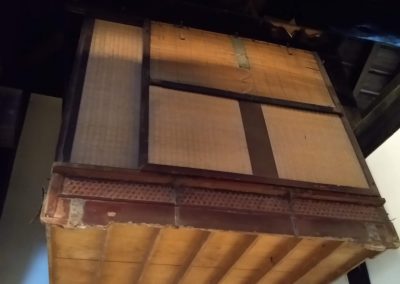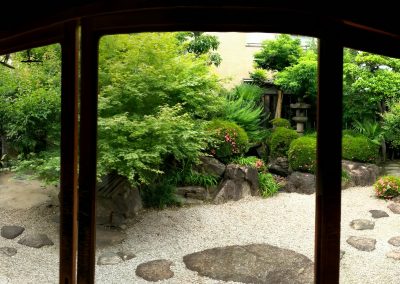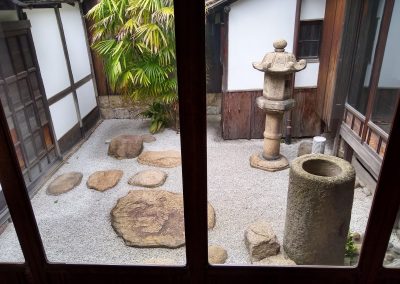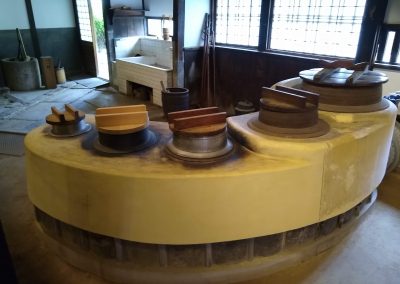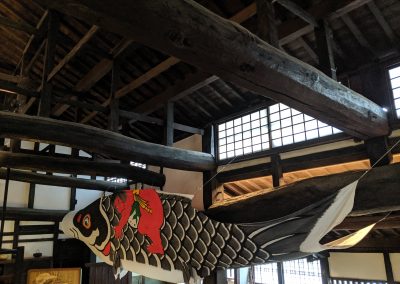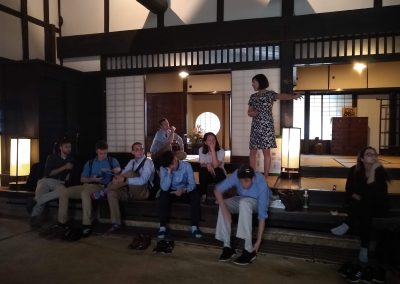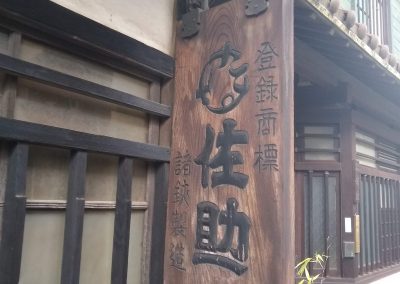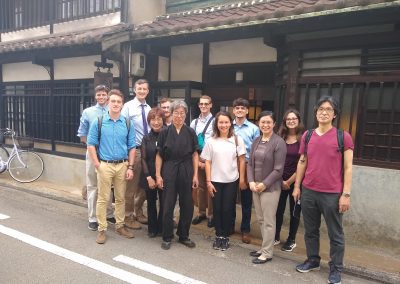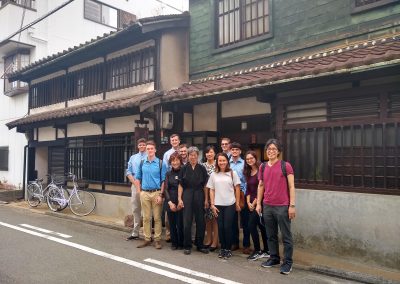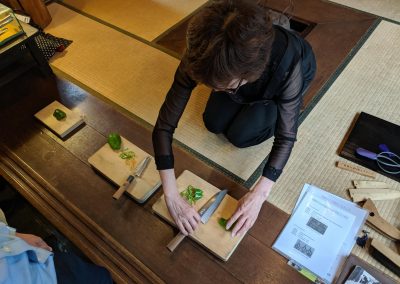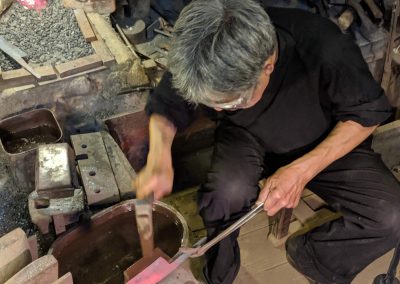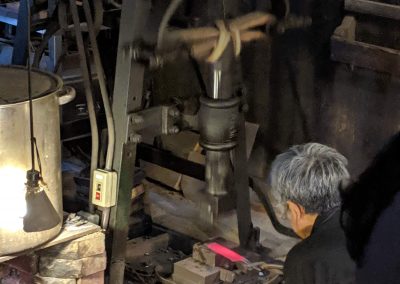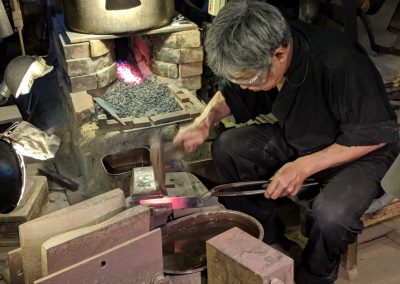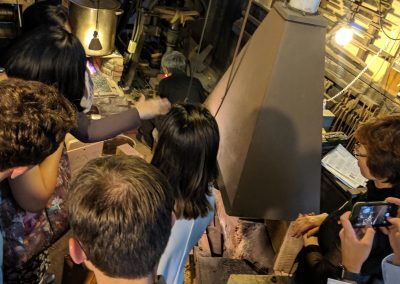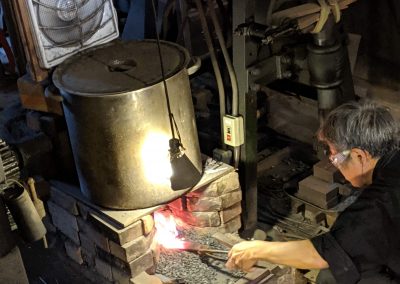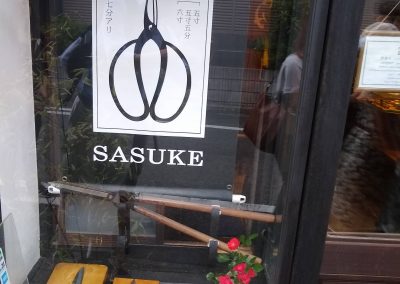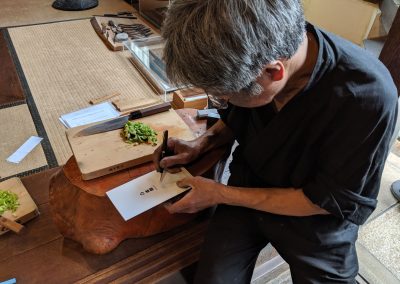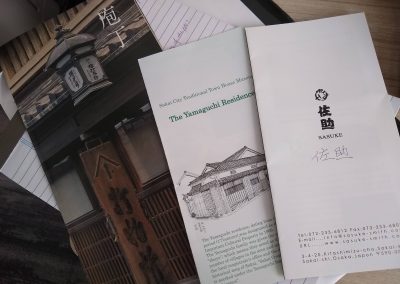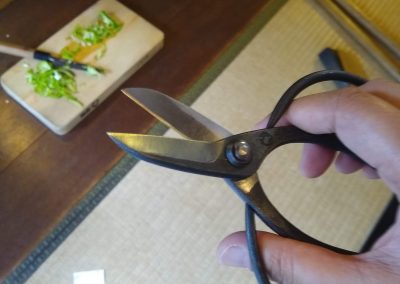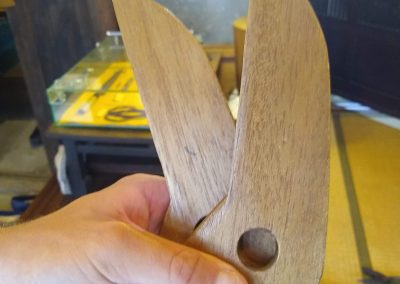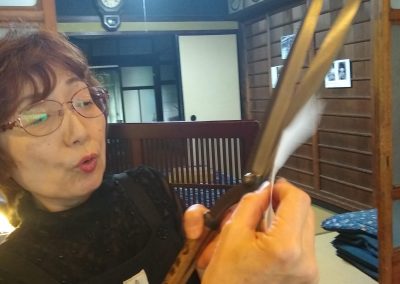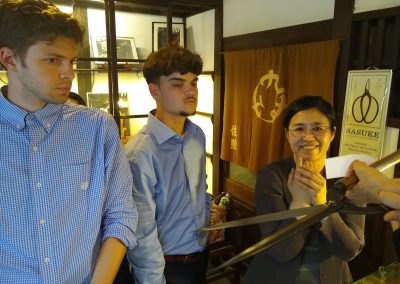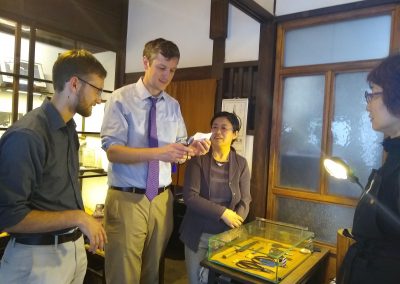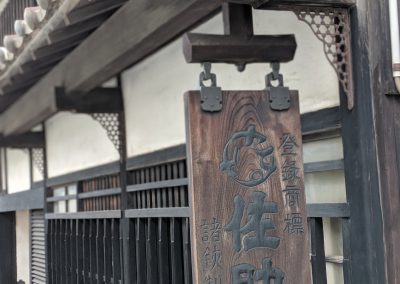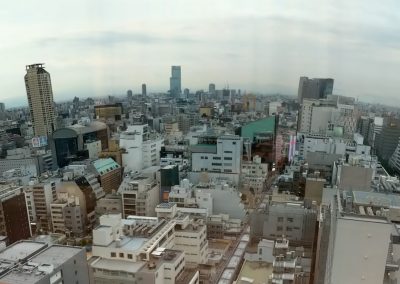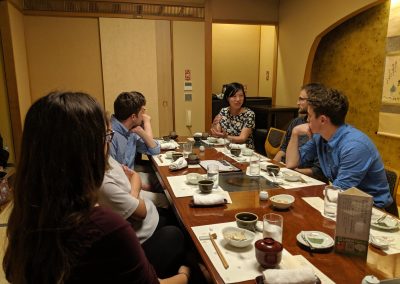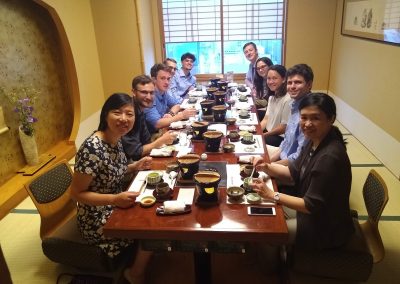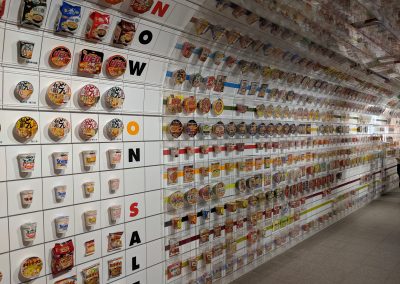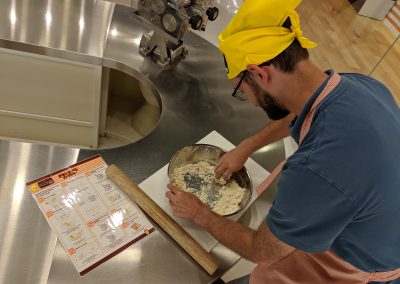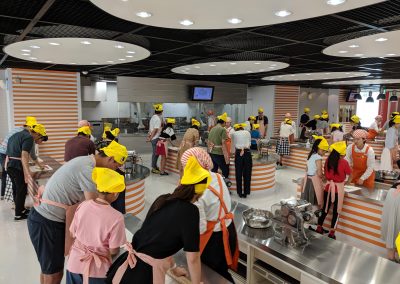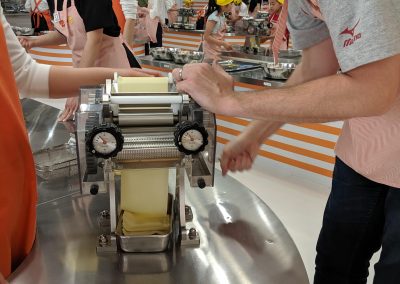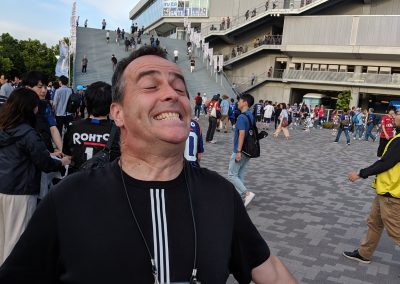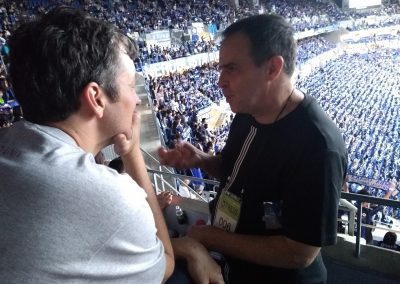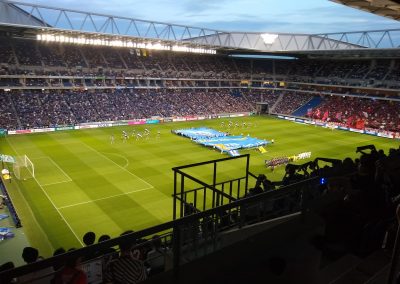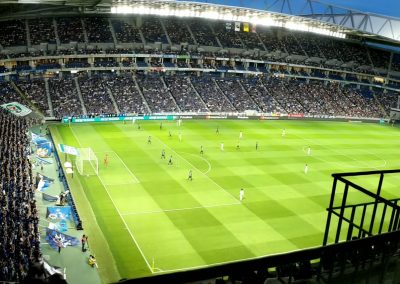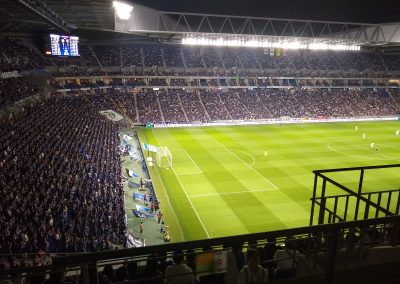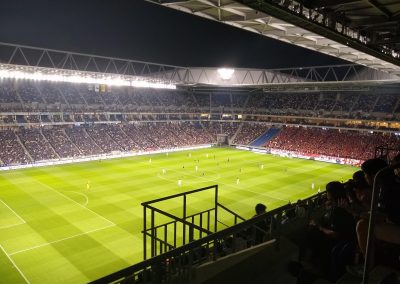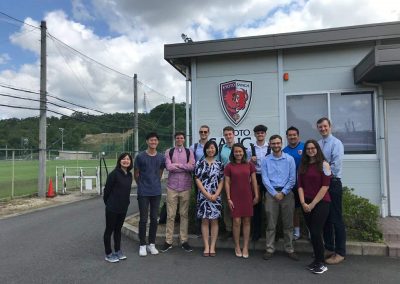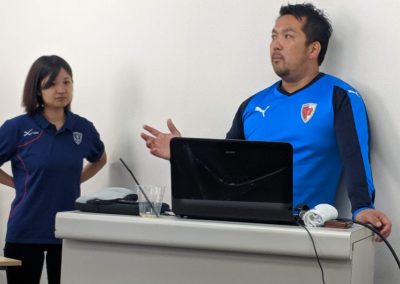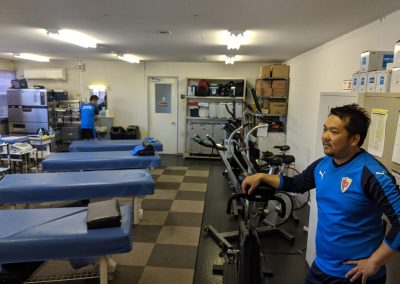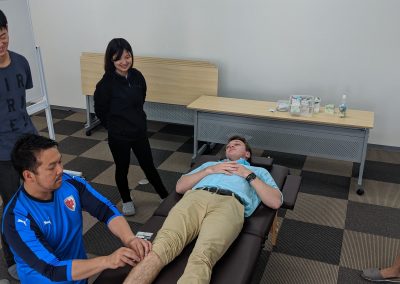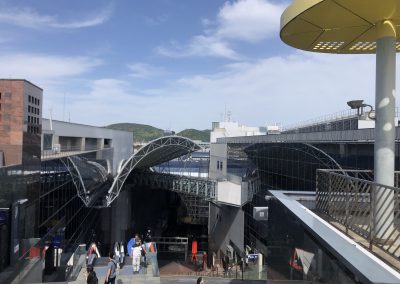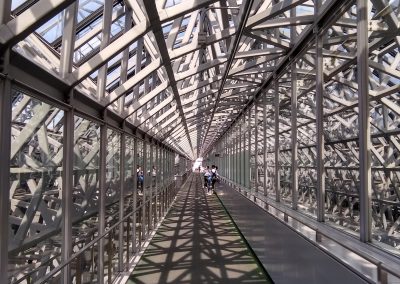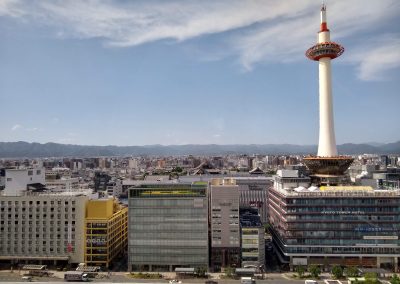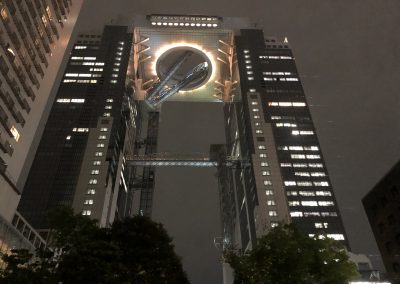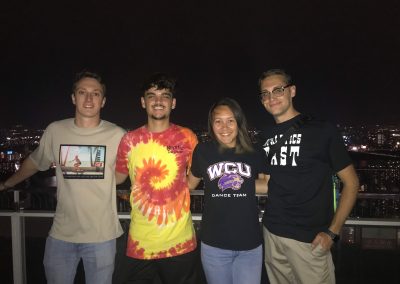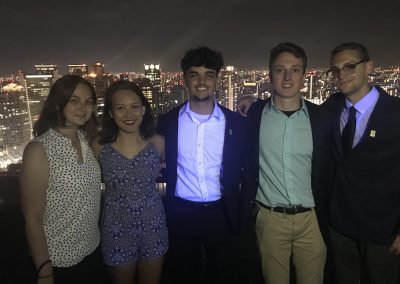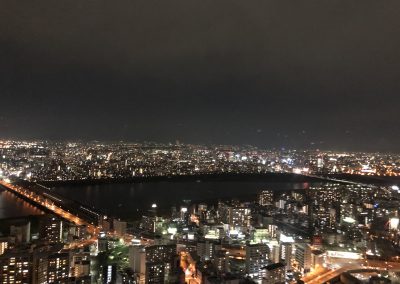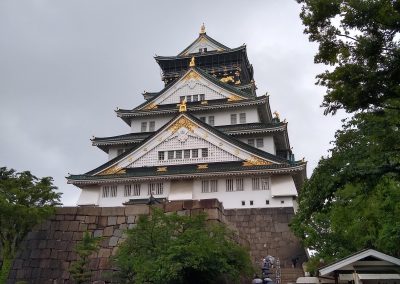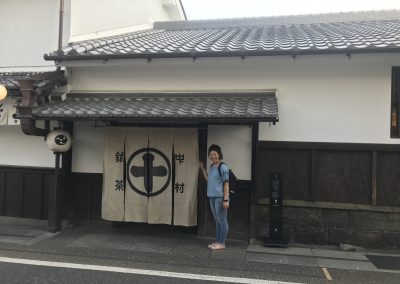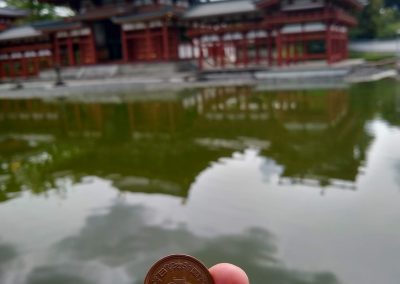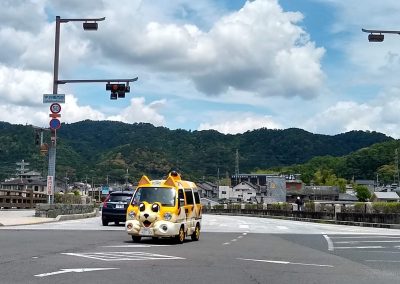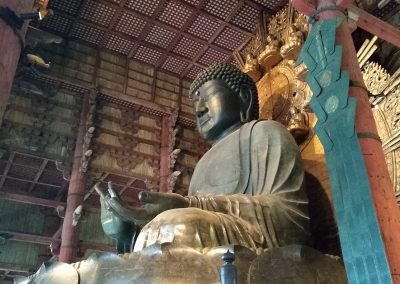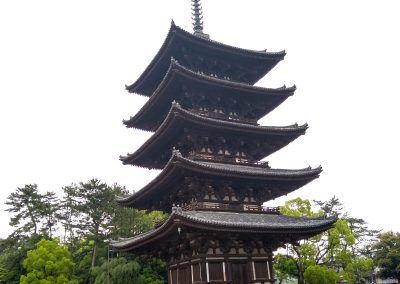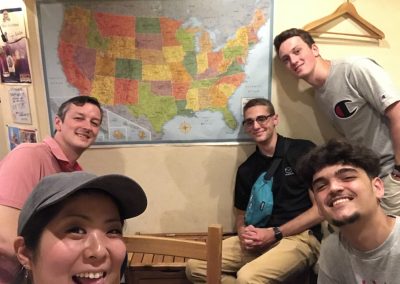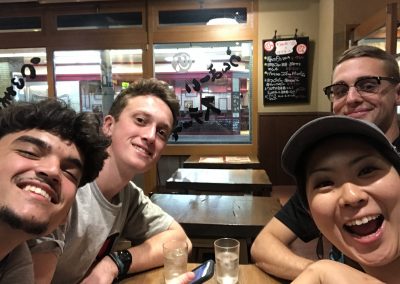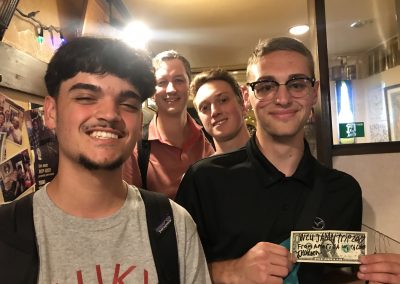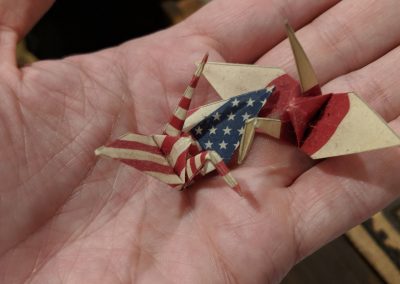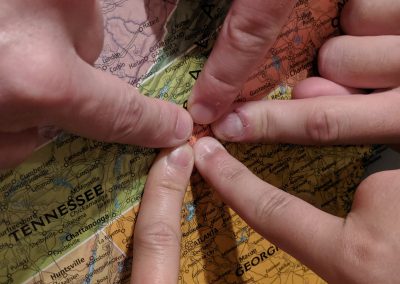ENGR 365 Global Engineering and Technology
co-offered with SM 350 Global Sport and Culture
Also in collaboration with JPN 493 Special Topics in Japanese
Japan, 2019
ENGR 365 Japan 2019 was led by Dr. Yanjun Yan. Note that there was another ENGR 365 session in 2019 led by Dr. Nelson Granda-Marulanda to Costa Rica. SM 350 was led by Dr. David Tyler. Both ENGR 365 Japan and SM 350 courses were offered as a combo class. Read the WCU news article about this trip here.
The JPN 493 class was led by professor Soichiro Motohashi, which was separate from the ENGR 365 / SM 350 class but along similar travel routes. The instructors had met together many times to plan the trips. Both classes enjoyed several cultural activities together.
Next year in summer 2020, if you want to visit Japan in a WCU cohort, please contact professor Motohashi at smotohashi@wcu.edu or visit him in McKee 131B, to join the JPN 493 course and earn 3 WCU credits. Many of the JPN 493 students will have taken some Japanese language course (and they can come to your aid when needed), but it is not required for you to have any prior knowledge in Japanese language to join JPN 493. What is required in JPN 493 is your curiosity to experience the Japanese culture with an open mind and heart. Update on Mar 3, 2020: Due to COVID-19, the Japan trip 2020 is cancelled. Student safety is always our number one priority. The world is interconnected, that’s why we cross bridges to understand each other. We will continue our exploration and learning when it is safe to do so in the future. Update on Apr 25, 2020: Our Japan traveler, Alex Sapp, and his roommates/friends, are 3D-printing face shields in their apartment during the lock-down (as reported by the Fox Carolina News) to support our medical staff on the front line. Here is the WCU news about it.
The 2019 ENGR365/SM350 class left US from everyone’s chosen airport on May 15th and met together in Tokyo on May 16th. The trip ended on June 4, 2019 in Osaka. The class traveled in four areas: Tokyo → Nagoya / Toyota → Hiroshima → Osaka / Kyoto / Himeji / Kobe / Nara. The overall map in Japan is provided below.
Tokyo
Nagoya
Kyoto
Osaka
Nara
Kobe
Horoshima
Himeji
The companies, factories, universities, museums, and attractions that we visited are marked on four area maps, together with the galleries of some highlights.
APA Sugamo
https://www.booking.com/hotel/jp/apa-sugamo-ekimae.html
APA Hotel Sugamo Ekimae
170-0002 Tokyo Prefecture, Toshima-
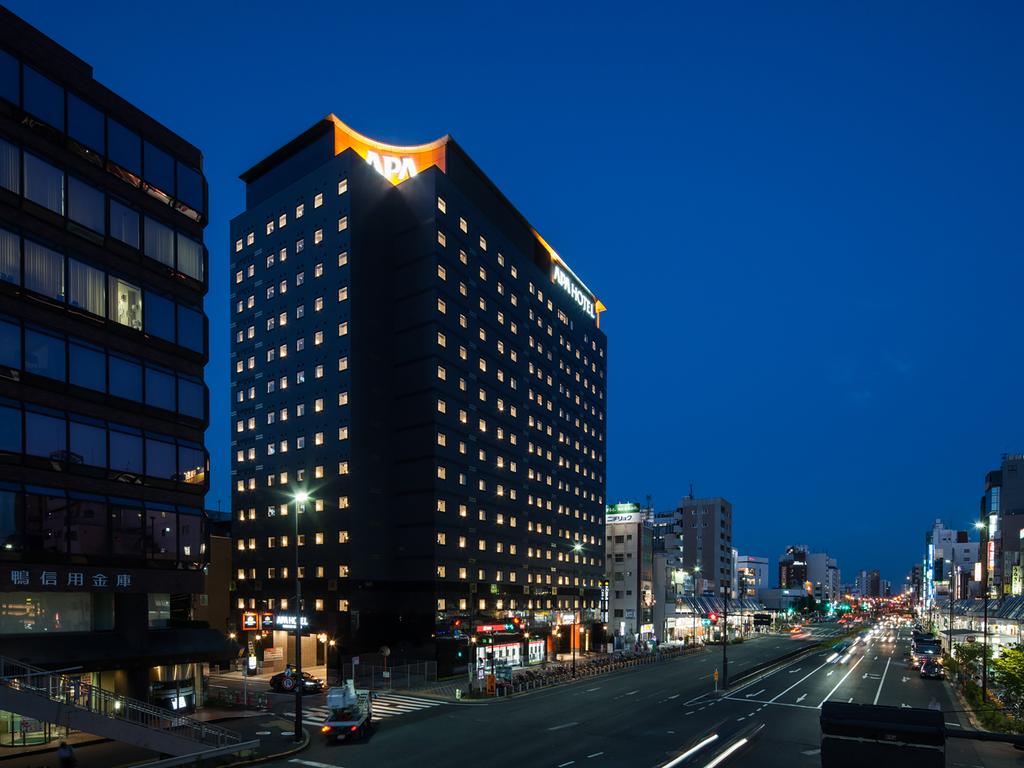
One of our top picks in Tokyo
Air-conditioned rooms at APA Hotel Sugamo Ekimae comes with an original mattress optimizing weight distribution, a flat-screen TV with BBC World News channel and an electric kettle. The private bathroom comes with free toiletries, slippers and a hairdryer.
Free luggage storage and newspaper services are available at the 24-hour front desk. Guests can soak in the open-air bath. Massage treatments and cleaning services are also available at an additional charge.
Ikebukuro Train Station is a 9-minute ride away on the JR Yamanote Line, while Tokyo Dome City is a 13-minute train ride from the property. Guests can also visit the Ueno Zoo or shop for electronic gadgets at Akihabara, both located a 20-minute drive away. Haneda International Airport can be reached with a 46-minute train ride from the nearby train station.
Toshima is a great choice for travelers interested in shopping, local food
We speak your language!
Advanced Technology Exhibition Hall @TEPIA
https://www.jetro.go.jp/en/ind_tourism/tepia.html
Advanced Technology Exhibition Hall @TEPIA
TEPIA disseminates information about innovative technologies developed by Japan's machinery and information industries and offers people of the chance to directly experience these technologies.
|
Website: http://www.tepia.jp/english/index.html Category: Manufacturing and infrastructure Region: Kanto |
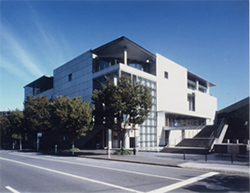
Access
Advanced Technology Exhibition Hall @TEPIA (Association for Technological Excellence Promoting Innovative Advances)
1st floor of TEPIA, 2-8-44 Kita Aoyama, Minato-ku, Tokyo 107-0061
Tokyo Metro Ginza Line: 4-minute walk from Exit No. 3 of Gaienmae Station
Admission
| Admission fee | Free |
|---|---|
| Working days and hours | Weekdays: 10:00 am ‒ 6:00 pm Saturdays, Sundays and holidays: 10:00 am ‒ 5:00 pm |
| Closings | Mondays (Open when Monday falls on a holiday, but closed on the following Tuesday.) |
| Visitor capacity | 20 (per guided tour in English) |
| Time required for a tour | About 1 hour |
| Language | English and Japanese |
| Reservation | Required https://www.tepia.jp/inspection/form.php |
| Other conditions | * English Guide Book * English leaflet |
Contact
Tel: 03-5474-6123
Odaiba: Miraikan, MegaWeb, teamLab, etc.
National Museum of Emerging Science and Innovation. Miraikan
https://www.miraikan.jst.go.jp/en/

MegaWeb (a Toyota City Showcase)
https://www.megaweb.gr.jp/about/english.html

teamLab Borderness
Subaru Sti Musuem
If you like cars and or Subarus, It is definitely worth checking out. I was in


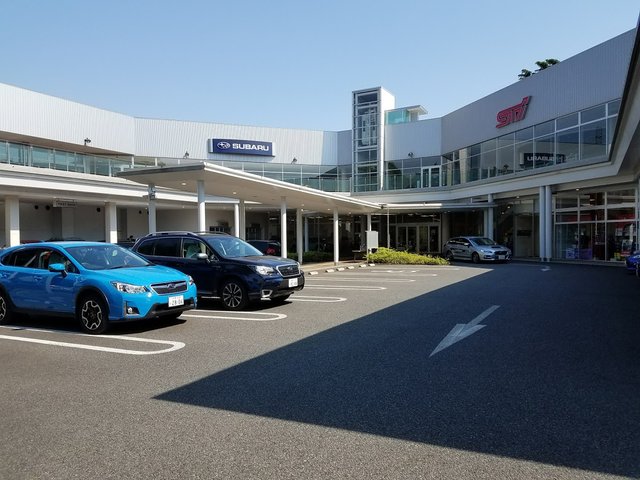
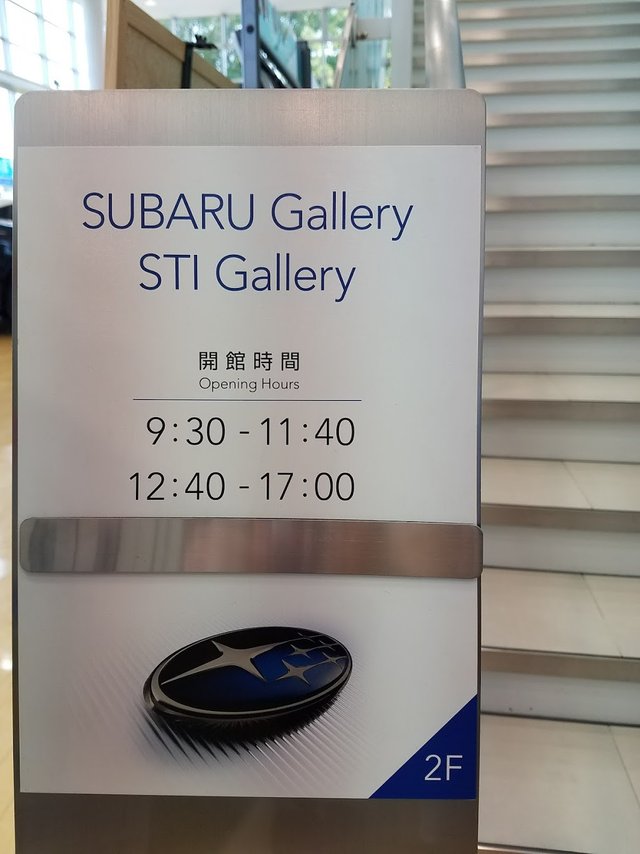
THE 22B STI 🔥🔥🔥
The Subaru 22B STI is a widebody WRX STI Impreza coupe that was produced in 1998. Only 400 22Bs were built, and according to
The 22B is basically a real rally car for the road. It is an awesome and beautiful vehicle. It might just be my #1 dream car. ( Its definitely in my top 3 😄)
Senso Ji - Sanja Matsuri
https://www.japan-guide.com/e/e3063.html
Sanja Matsuri
The Sanja Festival (三社祭, Sanja Matsuri) is an annual festival in the Asakusa district that usually takes place over the third full weekend in May. It is held in celebration of the three founders of Sensoji Temple, who are enshrined in Asakusa Shrine next door to the temple. Nearly two million people visit Asakusa over the three days of the festival, making it one of Tokyo's most popular festivals.
Akihabara
https://www.japan-guide.com/e/e3003.html
Akihabara (秋葉原), also called Akiba after a former local shrine, is a district in central Tokyo that is famous for its many electronics shops. In more recent years, Akihabara has gained recognition as the center of Japan's otaku (diehard fan) culture, and many shops and establishments devoted to anime and manga are now dispersed among the electronic stores in the district. On Sundays, Chuo Dori, the main street through the district, is closed to car traffic from 13:00 to 18:00 (until 17:00 from October through March).
Sumo viewing @ Kokugikan
http://www.sumo.or.jp/EnTicket/year_schedule/
| The May Tournament | Kokugikan | April 6, 2019 | April 30, 2019 | May 12, 2019 . May 26, 2019 |
Toshiba Science Musuem, with an exhibit of Karakuri Puppet
http://toshiba-mirai-kagakukan.jp/en/learn/history/toshiba_history/spirit/hisashige_tanaka/p01_1.htm
Kurume was the birthplace of the king of nineteenth-century Japanese inventors.

Reference:
Yumi-
Hisashige Tanaka was born on September 18, 1799, in what is now the city of Kurume in Fukuoka Prefecture on the island of Kyushu. His father, Yaemon, was a skilled maker of tortoiseshell ornaments, and the constant sight of him working implanted seeds of creativity in the young Hisashige.
At the tender age of eight, Hisashige devised what he called an "ink-stone case with a secret lock," featuring a cord that needed to be twisted in just the right way to pull out the drawer. When he took it to school and challenged several classmates to open the drawer, they eagerly tried but all failed. Then, to their wide-eyed astonishment, Hisashige swiftly opened it with ease. At the age of fourteen, he was commissioned to build a machine that could weave pictorial patterns on Kurume-
The genius of mechanical wonders was entertaining as well.
The Gokoku Shrine in Hisashige's hometown of Kurume celebrated a major festival twice a year, in the spring and fall. The biggest draw was the mechanical doll show, which is where the young Hisashige first encountered clockwork gadgetry. Fascinated by what he saw, Hisashige began creating gadgets himself and exhibited them at Gokoku Shrine. This is when people started calling him "the genius of mechanical wonders."
Although the eldest son, he asked his father to let his younger brother take over the family business, for he was determined to pursue success as an inventor. And so he continued to devote himself to the construction of mechanical dolls. For almost two years, they say, he never went outdoors, and he would go for seven or eight days on end without sleep. Then, eager for some new gems of knowledge to incorporate into his inventions, he traveled all the way to distant Edo; Tokyo, where he built a replica of an airgun from Holland. Through this
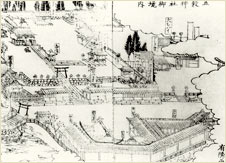
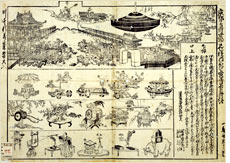
Reference:
(left)A map from Hisashige's day showing the precincts of the Gokoku Shrine [collection of the Kurume City Board of Education; photo courtesy of the Board]
(right)Advertisement for a mechanical doll show[National Science Museum]
Yumi-iri Doji;arrow-shooting boy, the ultimate mechanized doll.
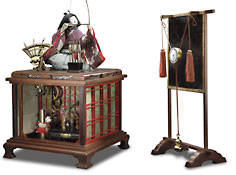
Reference:
Yumi-
Of all the numerous mechanical figures that Hisashige produced, the supreme masterpiece is undoubtedly Yumi-
Among the notable features of the piece is the use of brass for the clockwork mechanism, which guarantees sufficient strength and durability so that each motion glides smoothly into the next. A second feature is
Hisashige Tanaka's mechanical creations
Toro Ningyo ; puppet, from Yame Fukushima
The Toro Ningyo puppet shows in the Fukushima area of Yame City have a 250-year history. Performed every September at the Fukushima Hachiman Shrine, they have been designated an important intangible cultural asset by the Japanese government. The puppets are manipulated from backstage by means of rods — a technique devised by Hisashige, who presented his own mechanical doll shows on the same type of stage.
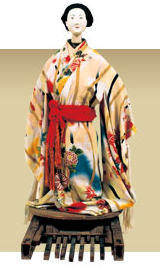
Reference:
Toro Ningyo; puppet, from Yame Fukushima
[collection of the Yame City Board of Education; photo courtesy of the Board]
Other mechanical dolls by Hisashige
| Kame no Hai-dai; sake-cup stand in the shape of a tortoise Place a full cup on the tortoise's back and it advances straight ahead. Place an empty cup on its back and the tortoise does a U-turn to where it came from. |
| Mechanical Hototogisu; cuckoo The bird, powered by a clockwork mechanism built into the base of the cage, chirps away while moving its head, beak, and wings. |
| Doji Hai-dai; sake-cup stand in the shape of a little boy Fill the cup and the little boy obligingly takes it to your guest. Once the guest drains the cup and places it back on the stand, the little boy turns around and returns to his original starting point. The figure, which measures about 20 cm tall, seems to hover in the air but in |
| Kobodaishi Himitsu-no Fude; Kobodaishi's secret ink brush A doll representing Kobodaishi; a great handwriting master, picks up an ink brush and draws a character in the air. Stroke by stroke, the same character appears simultaneously on a fusuma |
http://toshiba-mirai-kagakukan.jp/en/visit/information/hours_price.htm
Hours&Price
- Opening hours
- Tuesday - Friday 10:00-17:30
Saturday/Sunday/National Holidays 10:00-18:00 - Closed
- Closed on Mondays (unless a National Holiday) and other dates specified by the Museum
- Entry charge
- Free
※Please request English/Chinese information and group bookings in advance.
Opening ours and closed day will be changed as follows from April, 2019.
- Opening hours
- Tuesday - Friday 9:30-17:00
Saturday/Sunday/National Holidays 10:00-17:00 - Closed
- Closed on Mondays (unless a National Holiday) ,fourth Sundays, and other dates specified by the Museum
Related Links
Visit(How to use the Museum) Top Page
Yokohama B-Corsairs Basketball Team Meeting
JFA
Nike Japan
Shinagawa Station
locker to store luggage
Ippudo Roppongi, the best Ramen in Tokyo
Toshiba Science Museum
MagLev (magnetic levitation) train mechanism demonstration, Karakuri Ningyo (mechanical robot since the 17th century), Toshiba innovations, etc.
Miraikan: National Museum of Emerging Science and Innovation
ASIMO and other humanoid robots, space lab, 3D production for art and advertisement, etc.
MegaWeb Toyota showcase
“Supra is back to Japan!” debut event, regular and paralympic Olympic experience, all the past and current glories
teamLab Borderless
An interactive and dynamic art exhibit enclosed in a two-story building, enabled by tons of sensors and optical parts
Subaru STI museum/dealership
Invited to sit in the first 22B STI and World Rally winner cars, and to hold the championship cup brought out by the staff that was not even on display!!!
Sumo watching in Ryōgoku Kokugikan
A ceremony to please the God more than a sport. All the staff members must be past Sumo players themselves
More at Odaiba, Tokyo Skytree, and other places in Tokyo
Chukyo University Toyota Campus Dorm
青雲館 Seiunkan for students
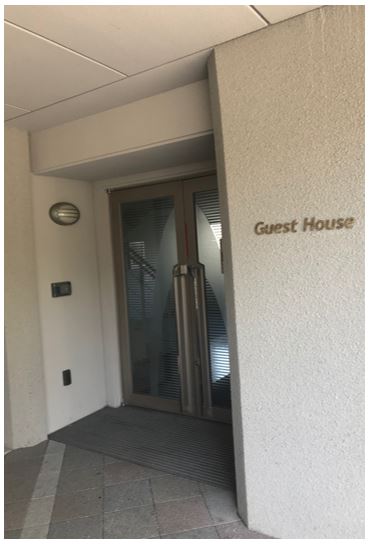
豊友館 Hoyukan for teachers
- Check in is at
3pm /Check out is at10am - There will be eight beds in one
room, but may have fewer than eight people. When you stay in this room while at Chukyo you can only use one bed per person. You shouldn't switch beds nor touch the beds you do not use, or they will charge you double. - Laundry can be done on the 5th floor, but you must buy your own detergent.
3th floor is for female- 4th floor is for male
- There is one large bathroom per floor
Toyota Motomachi Plant (LFA, etc.)
Toyota Tsutsumi Plant
APA Hotel Gifu Hashima Ekimae
The SCMaglev and Railway Park (リニア・鉄道館 ~夢と想い出のミュージアム~)
Mizuno Technics, to manufacture golf clubs, baseball bats, etc.
Yakiniku Kachan (Japanese barbecue)
Shoan Sushi Restaurant
iLimA
https://ameblo.jp/ilimacom/entry-12027115264.html
https://www.chukyo-u.ac.jp/news/2019/05/013757.html
ウェスタンカロライナ大学の学生・教員らが中京大学を訪問 工学部学生や硬式野球部員らと交流
Tokai-Hokuriku Expressway Kawashima Rest Area (You won't believe that it is just a rest area!)
There was a BBC documentary about Toyota Motomachi plant’s LFA (Toyota’s first super car) project several years ago. The LFA Chief Engineer, Tanahashi Haruhiku, was featured in this video, as shown below.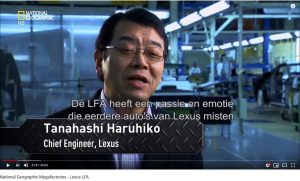
Before the trip, the class watched this video, did research on the car models manufactured at the Motomachi and Tsutsumi plants, and attended a talk specially given by Dr. Sudhir Kaul on general car manufacturing. During our trip, we talked to Mr. Haruhiku and many other engineers at both Toyota plants. No photos were allowed inside the factories, but we had thoroughly enjoyed watching the entire manufacturing cycle from stamping, welding, assembly, to testing. We even rode a car on a test track of various terrians at the Tsutsumi plant.
We, as well as Motohashi Sensei’s class, also interacted with Chukyo University quite a bit (although not together). Read the Chukyo university’s news article here.
Words can’t express how grateful we are of the special tours, made possible by all of our hosts.
Toyota Motomachi Plant
To produce Lexus LFA, Crown, etc., a testbed for innovations. The bus is powered by hydrogen fuel cell and will be used in Olympics 2020 in Tokyo.
Toyota Women Softball Team
Monica was a Team USA player in Olympics 2008 in Beijing, Ali is a Team USA player in Olympics 2020 in Tokyo. They play on the Toyota team in Japan when they are not training in the U.S.
Chukyo University Softball Team
The students and team members played ball throwing and catching, and had dinner together later.
Our dear Miku
Miku used to study at WCU. She drove us around and arranged ALL of our behind-the-scenes visits in the Nagoya region. Her athlete restaurant, iLima, was our favorite. A student got a a very cool customized jacket in her husband’s sporting goods store.
Toyota Tsutsumi Plant
To mass-produce Prius, etc. for both domestic and international markets. Use more green power and focus more on energy efficiency
SCMaglev and Railway Park
High speed trains’ past, presence, and future, activities and simulation theater related to MagLev train, etc.
Sushi dinner at Shou’An
The chef served the sushi one type after the other, and adjusted individual offering based on customer reaction
Dr. Mekada’s lab
A tour and three talks in the Department of Information Engineering, School of Engineering, at Chukyo University
Mizuno Technics
There are only a handful of professional baseball bat makers, each with 20+ years of experience
Yakiniku (Japanese barbecue) dinner
Students tried new food they had never had before. Black sesame ice cream is very tasty but rarely seen elsewhere in Japan
APA Hotel Hiroshima-Ekimae Ohashi
APA Hotel Hiroshima-Ekimae Ohashi
732-0828 Hiroshima, Hiroshima, Minami-ku Kyobashicho 2-26, Japan –
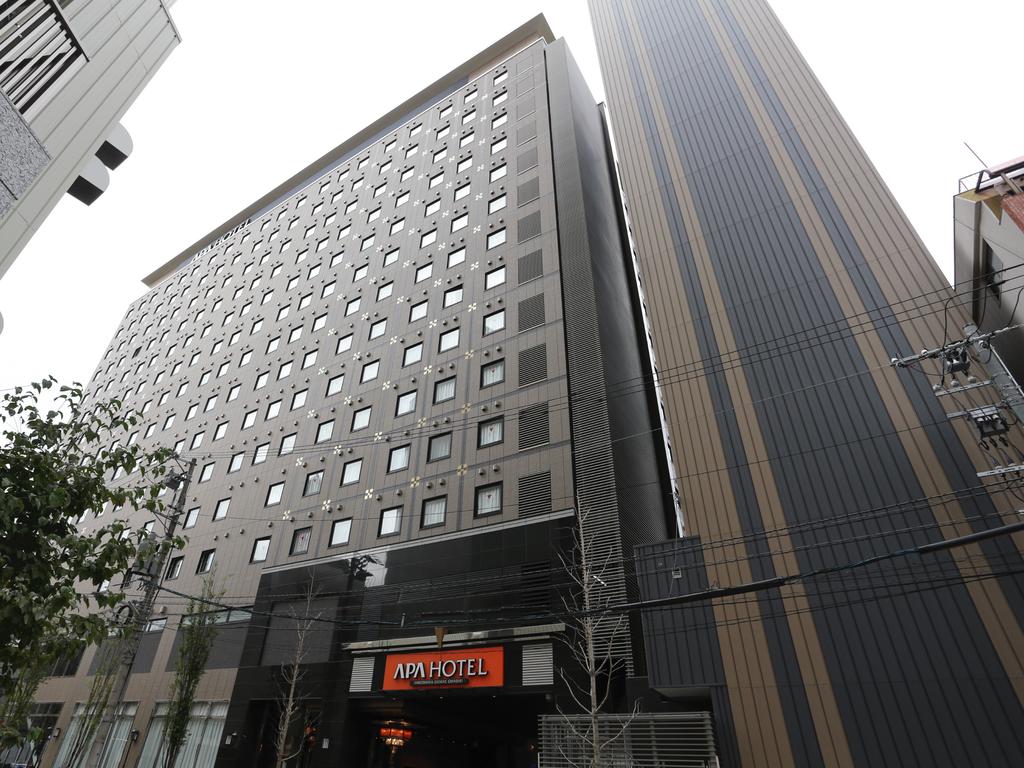
One of our best sellers in Hiroshima! Boasting spacious public baths, APA Hotel Hiroshima-Ekimae Ohashi is located a 4-minute walk from JR Hiroshima Station. Free WiFi is provided in all rooms.
Rooms at Hiroshima-Ekimae Ohashi APA Hotel comes with a flat-screen TV with BBC world news, a fridge and an electric kettle. Each room has an original mattress optimizing weight distribution and a private bathroom with a high-tech toilet and a hairdryer.
There is a 24-hour front desk with luggage storage at the property. Laundry and photocopying services are available at a surcharge.
Hiroshima Peace Memorial Park is a 15-minute tram ride away, while Shukkeien is a 10-minute walk from APA Hotel Hiroshima-Ekimae Ohashi. The popular Itsukushima
This is our guests' favorite part of Hiroshima, according to independent reviews.
We speak your language!
Peace Museum
March-July 8:30-18:00
Last entry is 30 min. before closing time
The Museum does not have a reservation system. We do not take reservations.
● Please do not touch the exhibits or display cases (except the Hands-on Exhibits).
● Please keep quiet so as not to disturb other visitors.
● Large bags are not allowed into the Museum. (Coin lockers are available on the 1st floor of the East Building. To view the floor map, click here.)
● When using writing utensils, please be careful not to deface the artifacts.
● Video and photography without flash is allowed for personal purposes (no application is required.) . However, tripods and selfie sticks are not allowed in the museum.
● Please be especially careful not to disturb other visitors with the shutter sounds of your camera including cell-phones.
● Photography with flash and/or for the purpose of publication requires an application in advance. For more information, click here.
● Please refrain from talking on a cell phone in any part of the exhibition rooms.
● Eating and drinking are allowed only in the designated areas.
Visitors may consume food and drink in the Visitor’s Lounge on the 1st floor of the East Building. To view the floor map, click here.
● Smoking is not permitted in any part of the Museum.
The designated smoking area is located outside on the south side of the East Building (facing Heiwa Ōdōri Street).
● Please refrain from disturbing other visitors in the exhibition rooms.
● No dangerous objects may be brought into the Museum.
● Pets are not allowed in the Museum (except for guide, service, and hearing dogs).
● Please comply with any instructions given by the Museum staff.
Miyajima
Itsukushima, also known as Miyajima, is a small island in Hiroshima Bay, western Japan. It is known for its forests and ancient temples. Just offshore, the giant, orange Great Torii Gate is partially submerged at high tide. It marks the entrance to the Itsukushima Shrine, which was first built in the 12th century. Nearby, the Museum of History and Folklore has cultural artifacts in a 19th-century merchant's home.
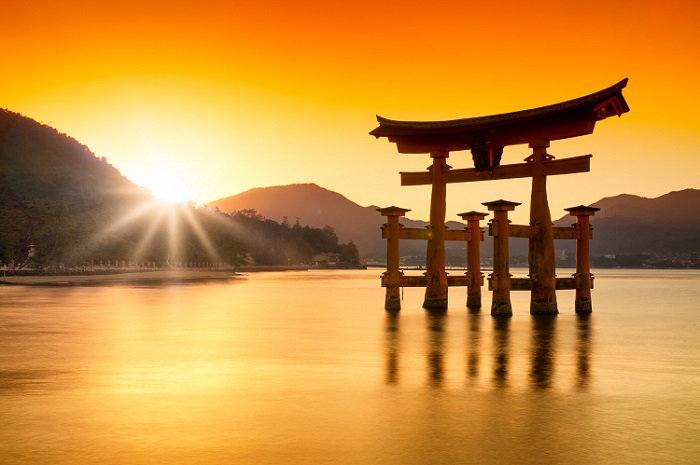
Mazda Museum
https://www.mazda.com/en/about/museum/reservations/
Individuals (up to 19)
English tour: 10 a.m.
Length of Tour: 90 min.
・Reservations for tours for which a travel agent or other person receives compensation will not be accepted.
・Stay with your guide. (No self-guided tours are allowed.)
・Visitors under the influence of alcohol will not be admitted.
・Eating and drinking
・Visitors with questions or concerns following the tour are requested to contact Mazda through the following:
- email: mazdamuseum@mail.mazda.co.jp
- FAX: 082-252-5654
Hiroshima Peace Memorial Museum
Unfortunately, after we left, the clock since the last nuclear test was reset multple times.
Miyajima (Itsukushima)
The gate of the shrine could be walked up to at low tide. The mountain view after a hike
Mazda Museum and Factory
The famous rotary engine that was proved to work by winning a race but discountinued as it tends to break easier than other design
Hello Kitty Shinkansen (bullet train)
National JR pass covers the fare
Daiwa Royal Hotel D-CITY Osaka Shin Umeda
https://www.booking.com/hotel/jp/daiwa-royal-hotel-d-city-osaka-shin-umeda.html
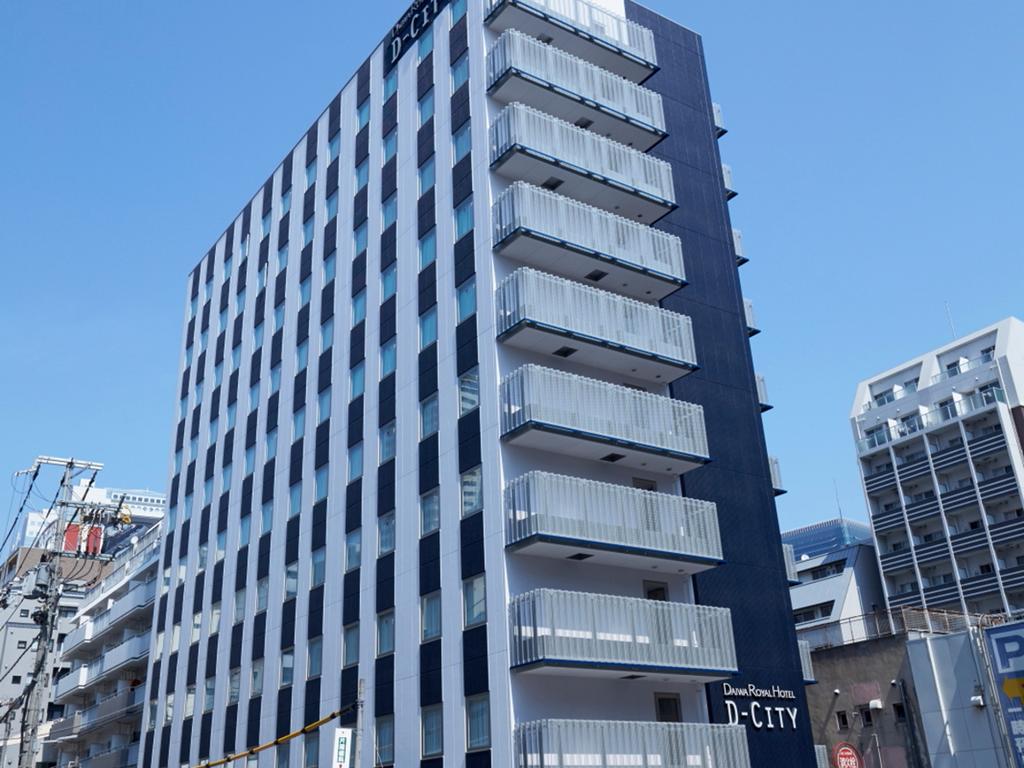
Daiwa Royal Hotel D-CITY Osaka Shin Umeda is offering accommodations in Osaka. Built in 2018, the property is within an 8-minute walk of Umeda Sky Building. The property provides a 24-hour front desk as well as free WiFi.
Guest rooms
Kuchu Teien Observatory is 0.4 miles from the
We speak your language!
Kochi Information Technology Co. Ltd.
TOP
製品紹介
製品紹介
当社製品
◯ デジタルサインシステム (DSS)
◯ CowsMobile®
◯ Bulls Mobile
☒ デジタルサインシステム (DSS)
check
デジタルサインシステムとは、デジタル技術を活用し、液晶モニタへ映像情報(テロップ、静止画、動画)を表示することにより、情報提示を行うことを目的としたシステムです。
通信ネットワークを使って、リアルタイムに映像を配信することができます。
デジタルサインシステムについて詳しく知りたい方はここをクリックしてください
☒ CowsMobile®(登録商標第5840205号)
check
CowsMobile®(※1)とは、PCのマイク音声やWEBカメラの映像、テキスト情報(チャット)、共有のホワイトボード(※2)を利用することにより、社外や遠隔地間における双方向でのコミュニケーションを通じて情報を共有するためのサービスです。
オプションとして、コミュニケーション中の内容を録画する機能もあります。
※1 CowsとはWEBコミュニケーションシステム(Conversation on wave system)の略語です
※2 ホワイトボード上で文字/線/記号を用いて図示した内容をシステム利用者と共有する機能です
CowsMobile®について詳しく知りたい方はここをクリックしてください
☒ Bulls Mobile
check
Bulls Mobileとは、GIS(※)のソフトウェア開発用キットです。
※ GIS…地理情報(Geografic Information System)という位置に関連づけられた様々な情報を作成、加工、管理、分析、可視化、共有するための情報技術(InformationTechnoligy)を利用したシステム
Bulls Mobileについて詳しく知りたい方はここをクリックしてください
Nara
Himeji Castle and Koko-en Garden
Fushimi Inari Shrine - Kiyomizu temple
https://digjapan.travel/en/spot/id=7829
https://www.japan-guide.com/e/e3915.html
http://inari.jp/
A beautiful shrine home to the god of thriving business
A popular destination for tourists because of its thousands of red torii gates, Fushimi Inari Taisha is the head of the approximately 30,000 Inari shrines located throughout Japan. This temple is said to be a good place to pray for success in business and industry.
In addition to torii, you may notice that there are a number of white fox statues throughout the shrine. Called
| HOURS | The shrine itself does not close; stores selling good luck charms and etc. are open 7:00am~6: |
|---|---|
| ADDRESS | 68 Fukakusa Yabunouchicho, Fushimi- |
| ACCESS | Just outside of Inari Station on the JR Nara Line |
| TEL | 075-641-7331 |
| WEBSITE | http://inari.jp/ (Japanese only) |
Izumiriki Seisakusho Knife Forging
https://www.jetro.go.jp/en/ind_tourism/izumiriki.html
http://www.sakai-tohji.co.jp/guide/company.php
| 本社営業所 | 大阪府堺市堺区九間町東1-1-5 |
|---|---|
| 臨海工場 | 大阪府堺市西区築港浜寺西町2 |
| 資料館<要予約> | 大阪府堺市堺区九間町東1-1-3 |
Izumiriki Seisakusho
Established in 1805, Izumiriki's kitchen tools have been in the hands of home cooks and professional chefs. Based upon the traditional technique, we keep trying new technology to manufacture the best kitchen knives that fulfill the high requirements of the pros.
At Izumiriki Seisakusho, visitors can see the process of "sharpening and straightening a blade," "fixing a handle to a knife," and "engraving a name on knife." Also, if visitors request, they can see the forging process.
|
Website: http://www.sakai-tohji.co.jp/ Category: Art, design and traditional goods Region: Kinki |
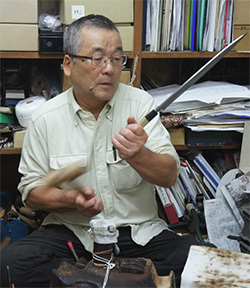
Access
Izumiriki Seisakusho Co.,Ltd.
1丁-1-5 Nishikinochōhigashi, Sakai-ku, Sakai-shi, Ōsaka-fu 590-0932, Japan
*Nankai Line Sakai station 15 minutes walk
*Nankai Line Sakai higashi station 15 minutes walk
*Hankai Line Shinmeicho station 1 minute walk
Admission
| Admission fee | Free |
|---|---|
| Working days and hours | Monday to Friday between 9:00 and 14:00 |
| Closings | Saturday, Sunday, public holidays, Bon and New Year holidays |
| Visitor capacity | 20 |
| Time required for a tour | 1-2 hour |
| Language | Japanese only |
| Reservation | Required via E-mail or FAX *Japanese only *3days prior to your visit. |
| Other conditions | *Visitors must arrange an interpreter *Guided tour is available *Photos allowed in certain areas *Showroom will open this winter (2013) *Visitors can purchase the products of Izumiriki Seisakusho |
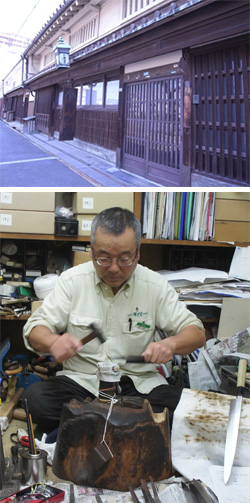
Contact
Tel: 072-238-0888 /072-229-9221 *Japanese only
E-mail: info@sakai-tohji.co.jp *Japanese only
This website from another workshop explains the forging process: http://www.mizunotanrenjo.jp/aboutjpknives_e.html We have checked that this other place does NOT offer a tour, but their info can be helpful.
The Momofuku Ando Instant Ramen Museum
Read this link to know the inventor's story.
https://www.jetro.go.jp/en/ind_tourism/monofuku_ando.html
The Momofuku Ando Instant Ramen Museum
The world's first instant noodle product, "Chicken Ramen," was invented by Momofuku Ando in
"Space Ram" was made as the instant noodles that traveled on the space shuttle Discovery with the Japanese astronaut in July 2005.
Visitors can make a "cup noodle" in the world's first cup noodle. They can also choose a soup, a cup design, and a favorite ingredient to make it. They can make their original cup noodle and take it away.
|
Website: http://www.instantramen-museum.jp/ Category: Food, agricultural and fishery products Region: Kinki |
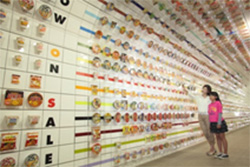
Access
The Momofuku Ando Instant Ramen Museum
8-25, Masumi-
Accessing Ikeda Station on the Hankyu Takarazuka line.
*Walk from Masumicho Homen Exit for approximately a 5 min.
*Go straight along ‘Men Road’
※It takes about 20 min from Umeda station to Ikeda station by train.
Admission
| Admission fee | Admission is free (The experience of making a cup noodle is charged. The fee of making a my cup noodle is 300JPY per cup.) |
|---|---|
| Working days and hours | 9:30-16:00 (Final Visitors can enjoy the tour without reservations. It may be closed earlier in the case of a crowded situation. |
| Closings | Closed: Tuesday (Next day is closed in the case of a holiday), year-end and new year |
| Language | Japanese, English and Chinese(Only brochure) |
| Reservation | Required By telephone 81(072)751-0825 |
| Other conditions | No reservations are required for entering "The Momofuku Ando Instant Ramen Museum" and "my cup noodle factory." Note: Please make a reservation for "Chicken Ramen Factory Tour" and group tour, when the size of |
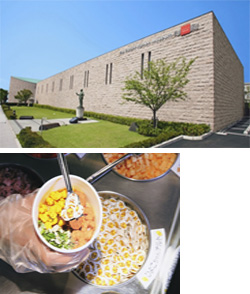
Contact
Tel: 81(072)-752-3484
Panasonic Stadium, J1-League Soccer Match: Gamba Osaka hosts Kashim
Kobe Regatta & Athletic Club
Master blacksmith Yasuhiro Hirakawa of scissors at Sasuke
http://sasuke.lolipop.jp/index2.html
http://www.sasuke-smith.com/contact1.html
3丁-4-20 Kitashimizuchō, Sakai-ku, Sakai-shi, Ōsaka-fu 590-0004, Japan
〒590-0004 大阪府堺市堺区北清水町3丁目 4-20 佐助
TEL : 072-233-6812
FAX : 072-233-6802
URL : www.sasuke-smith.com
営業 : 10:00~18:00
定休日:不定休
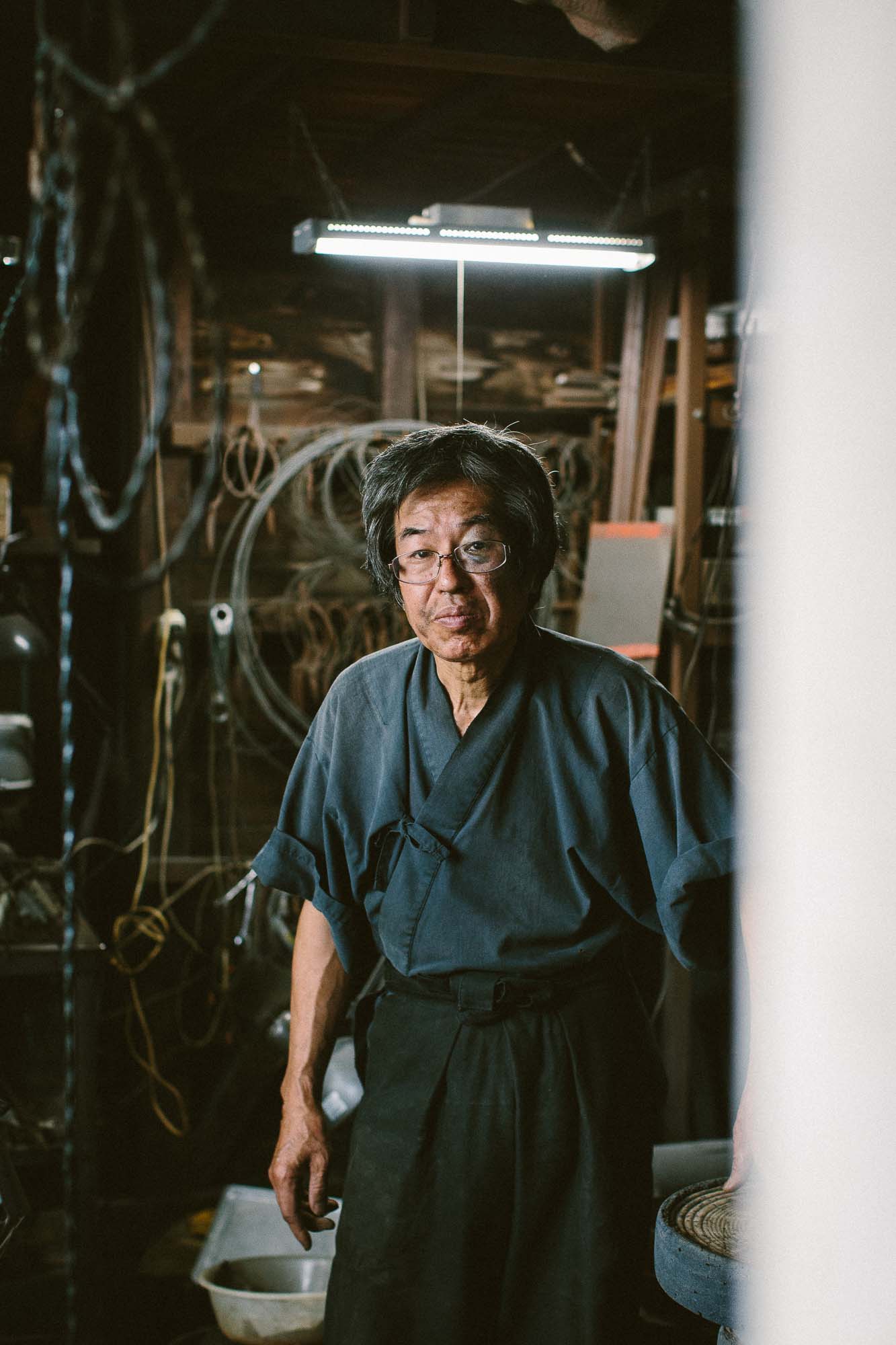
https://www.permanentstyle.com/2016/11/sasuke-master-japanese-knife-maker-sakai-osaka.html
http://www.adammarelliphoto.com/2010/12/old-world-masters-hotaro-namuro-yasuhiro-hirakawa/
Dinner at a Japanese friend's home
Our host says that "I’m planning to cook temaki-sushi together for dinner. After dinner, we will experience tea ceremony with Japanese sweets. You will also enjoy shamisen, koto, and shakuhachi performance, which is a traditional Japanese music. My friends will come and play for you."
Hanshin Koshien Stadium
Osaka Kyoiku University
Kiyomizu-dera Temple
https://www.japan-guide.com/e/e3901.html
Kiyomizudera (清水寺, literally "Pure Water Temple") is one of the most celebrated temples of Japan. It was founded in 780 on the site of the Otowa Waterfall in the wooded hills east of Kyoto, and derives its name from the fall's pure waters. The temple was originally associated with the Hosso sect, one of the oldest schools within Japanese Buddhism, but formed its own Kita Hosso sect in 1965. In 1994, the temple was added to the list of UNESCO world heritage sites.
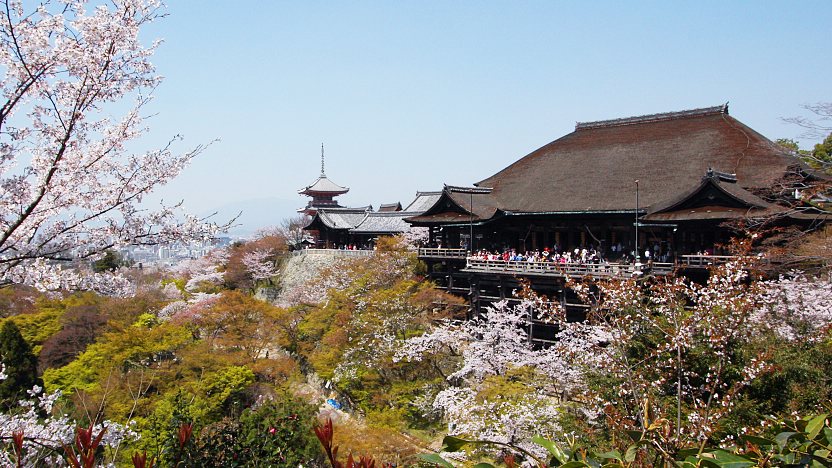
Kiyomizudera can be reached from Kyoto Station by bus number 100 or 206 (15 minutes, 230 yen). Get off at Gojo-zaka or Kiyomizu-michi bus stop, from where it is a ten minute uphill walk to the temple. Alternatively, Kiyomizudera is about a 20 minute walk from Kiyomizu-Gojo Station along the Keihan Railway Line.
Arashiyama Bamboo Grove
https://www.insidekyoto.com/arashiyama-bamboo-grove
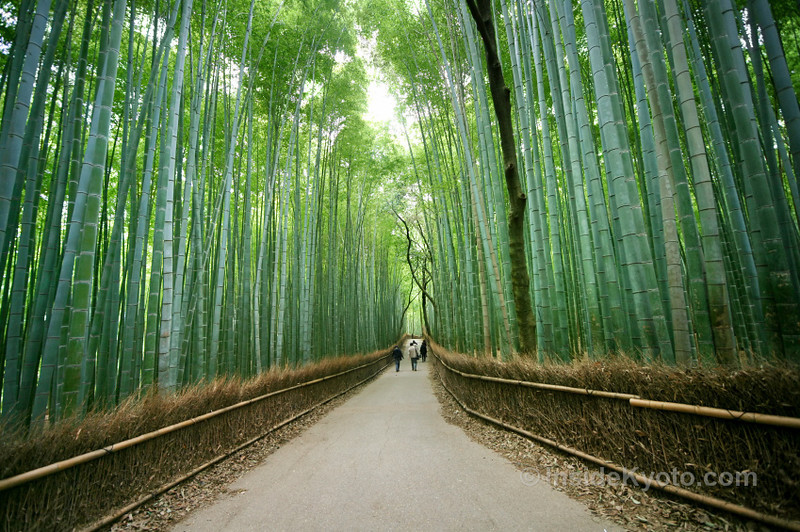
English address: Arashiyama, Ukyo-ku
Japanese address: 右京区嵐山
Click a Kyoto District for detailed info on attractions, places to eat and accommodation
Gion
https://www.japan-guide.com/e/e3902.html
Gion (祇園) is Kyoto's most famous geisha district, located around Shijo Avenue between Yasaka Shrine in the east and the Kamo River in the west. It is filled with shops, restaurants and ochaya (teahouses), where geiko (Kyoto dialect for geisha) and maiko (geiko apprentices) entertain.
Gion attracts tourists with its high concentration of traditional wooden machiya merchant houses. Due to the fact that property taxes were formerly based upon street frontage, the houses were built with narrow facades only five to six meters wide, but extend up to twenty meters in from the street.
Many tourists visit Gion hoping to catch a glimpse of a geiko or maiko on their way to or from an engagement at an ochaya in the evenings or while running errands during the day. However, if you spot a geiko or maiko, act respectfully. Complaints about tourists behaving like ruthless paparazzi are on the increase in recent years.
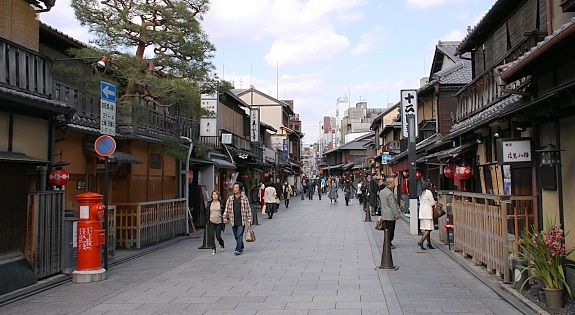
A visit to Gion is best combined with a stroll through the nearby Higashiyama Districtbetween Yasaka Shrine and Kiyomizudera. This area has more preserved streets and traditional shops selling all kinds of local foods, crafts and souvenirs.
Gion can be reached from Kyoto Station by bus number 100 or 206 (20 minutes, 230 yen). Get off at Gion bus stop. Alternatively, the closest train stations are Gion Shijo Station on the Keihan Line and Kawaramachi Station on the Hankyu Line.
Kyoto Sanga Training Center at Sanga Town
Get there from Joyo station (城陽駅)
Arashiyama Monkey Park Iwatayama
https://culturalxplorer.com/monkeys-bamboo-arashiyama-kyoto-japan/
Dinner at a Japanese friend’s house
Our friends hosted us at home with temaki-sushi, traditional Japanese tea ceremony, and traditional Japanese music (Shakuhachi, Koto, and Shamisen)
Himeji Castle and Kokoen Garden
A national treasure and the first world heritage site in Japan, VR and AR tour guide on phone app
Kobe Regatta & Athletic Club
A sports club founded on September 23, 1870, on the secured land on the eastern side of the foreign settlement
Hanshin baseball game
Hanshin (阪神) team (short for Osaka (大阪)-Kobe (神戸)), is the easiest conversation starter in the Kansei area, given the generations of fans here.
Kochi Information Technology Co. Ltd
Their real-time operating system is what makes Suica Cards, etc. possible in rail systems. Their system is also used in patient management in hospitals, first responder system, etc.
Sumiyoshi Taisha
One of Japan’s oldest shrines. The roof is made of the grass that makes tatami, very durable and waterproof. Yet, the habitat of such grass is shrinking, making it hard to obtain now.
Knife Forging at Izumiriki Seisakusho
A thorough tour on knife forging and handle fixing. The students tried knife sharpening a bit.
Scissor and knife forging at Sasuke
$35,000 Bonsai Scissors are made here by Mr. Yasuhiro Hirakawa.
Cup Noodles Museum Osaka Ikeda
Intersection of marketing, engineering and cross-cultural innovation. You could download an app to take a virtual tour.
Kyoto Sanga F.C. training facility
Eye-opening to learn different philosophies and alternative treatments, besides common practice
Kyoto Station, Umeda tower, Osaka Castle, Uji, Nara, and other places
See more photos and watch videos in this album and read more explanations in this album.
Acknowledgement
The 2019 trip was an interdisciplinary collaboration among three faculty-led travel courses (ENGR 365, SM 350, and JPN 493) that took a few years to finally materizalize. It wouldn’t happen without many people’s help.
Colleagues and Leadership
In no particular order, we thank
- Professor Soichiro Motohashi for establishing many site-visit opportunities, which simply would not happen if without his help, helping Dr. Yan to refresh her Japanese, and finding interpretors when needed;
- Dr. David Tyler for collaborating in this two-course combo on a single trip and sharing his expertise down to every detail;
- Dr. Scott Rader for sharing his course proposal that sparked Dr. Yan’s desire to lead a trip to Japan in the first place and his many suggestions later on to help shape this interdisciplinary collaboration between engineering, sport management and Japanese programs. Dr. Rader also offered a talk on Japanese culture to the class before the trip;
- Dr. Sudhir Kaul for giving a comprehensive talk on car manufacturing to the class before the trip;
- Dr. Ling LeBeau, the director of International Programs and Services, for her continuous encouragement and guidance;
- Mr. Neil Torda (torda@wcu.edu) for supporting this website’s development (https://yan.wcu.edu/) with the best solution for every feature that is asked; and
- Dr. Hugh Jack, School Director of Engineering and Technology and Cass Ballenger Distinguished Professor, for his unwavering support at every step of the course development and the financial support, when needed, without hesitation.
Hosts
The names of our hosts who are not public figures are omitted for privacy. Our appreciation extends to all who have welcomed us.
In no particular order, we thank
- The staff at Yokohama B-Corsairs. Go!! B-COR!!
- Mr. Okumura Kouki who is an experienced craftsman to work with gold and talked to us about it
- Senior Director at United Entertainment Group
- Staff at Nike
- Miku in Nagoya, a WCU alum, who arranged our Nagoya itineries and accompanied us and drove us during our entire stay there, led us to great restaurants including her iLima athlete restaurant, sushi course dinner and yakiniku (Japanese barbecue).
- General Manager and many other engineers and staff members at Toyota Motomachi Plant and Tsutsumi Plant
- Monica Abbott and Ali Aguilar
- Senior Manager and his staff at Mizuno Technics Corporation
- A professor in the Department of Information Engineering, School of Engineering, and his students at Chukyo University
- Baseball Team Head Coach and his team at Chukyo University
- President of the Kobe Regatta & Athletic Club
- Atheletic Trainer and his colleagues at Kyoto Sanga F.C.
- Staff at the Center for Global Education and Research and professors in Physical Education at Osaka Kyoiku University
- Dr. Wang in Osaka, who kindly offered each one of us a pottery cup hand-made by her husband, and arranged and accompanied us in multiple activities in Osaka, and helped us in interpretation. She also reserved and led us to a traditional Japanese course dinner.
- Takamichi Sensei who helped arrange our activities and guided us in Sakai
- Our Japanese friends who hosted us a dinner at home with temachi-sushi and many other delights, the traditional Japanese tea ceremony, and the traditional Japanese musical instruments (Shakuhachi, Koto, and Shamisen).
- President, Manager, and Chief Designer at Kochi Information Technology Co. Ltd
- Mr. Nobuta at Izumiriki Seisakusho
- Mr. Yasuhiro Hirakawa at Sasuke
- Staff at the following museums or organizations who offered us excellent info and extra help, whenever needed, and extra demonstrations without us even asking:
- Toshiba Science Museum,
- National Museum of Emerging Science and Innovation,
- Toyota Megaweb,
- Subaru STI Museum, we were invited to sit in the original winning cars and hold the championship cup!
- TEPIA Advanced Technology Exhibition Hall
- SCMAGLEV and Railway Park,
- Hiroshima Peace Memorial Museum,
- Mazda Museum,
- Cup Noodles Museum Osaka Ikeda.
- Staff at the hotels, train stations, restaurants, shops, and many other places, who took the efforts to help us as best as they could,
- and many others who have met with us and interacted with us.
